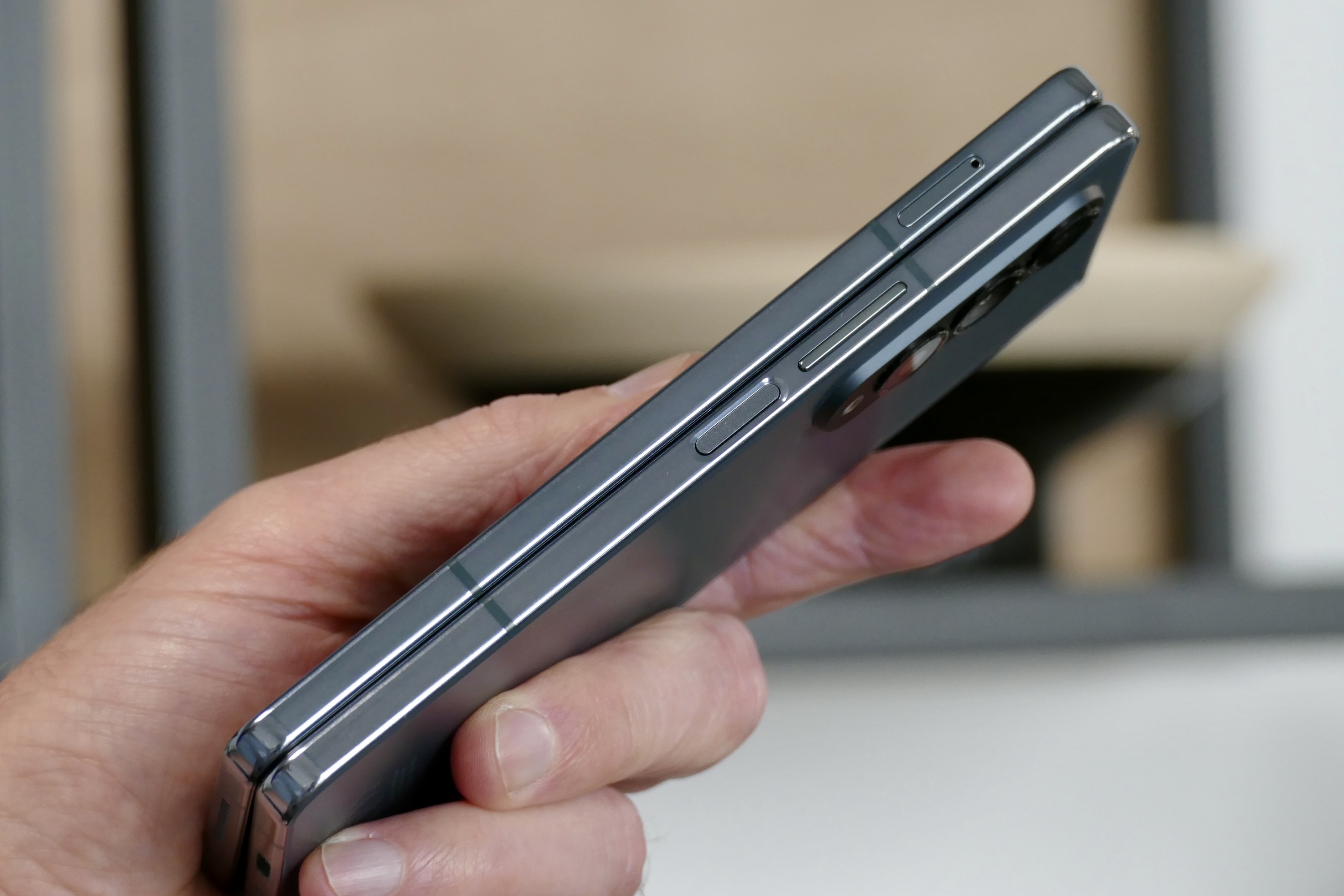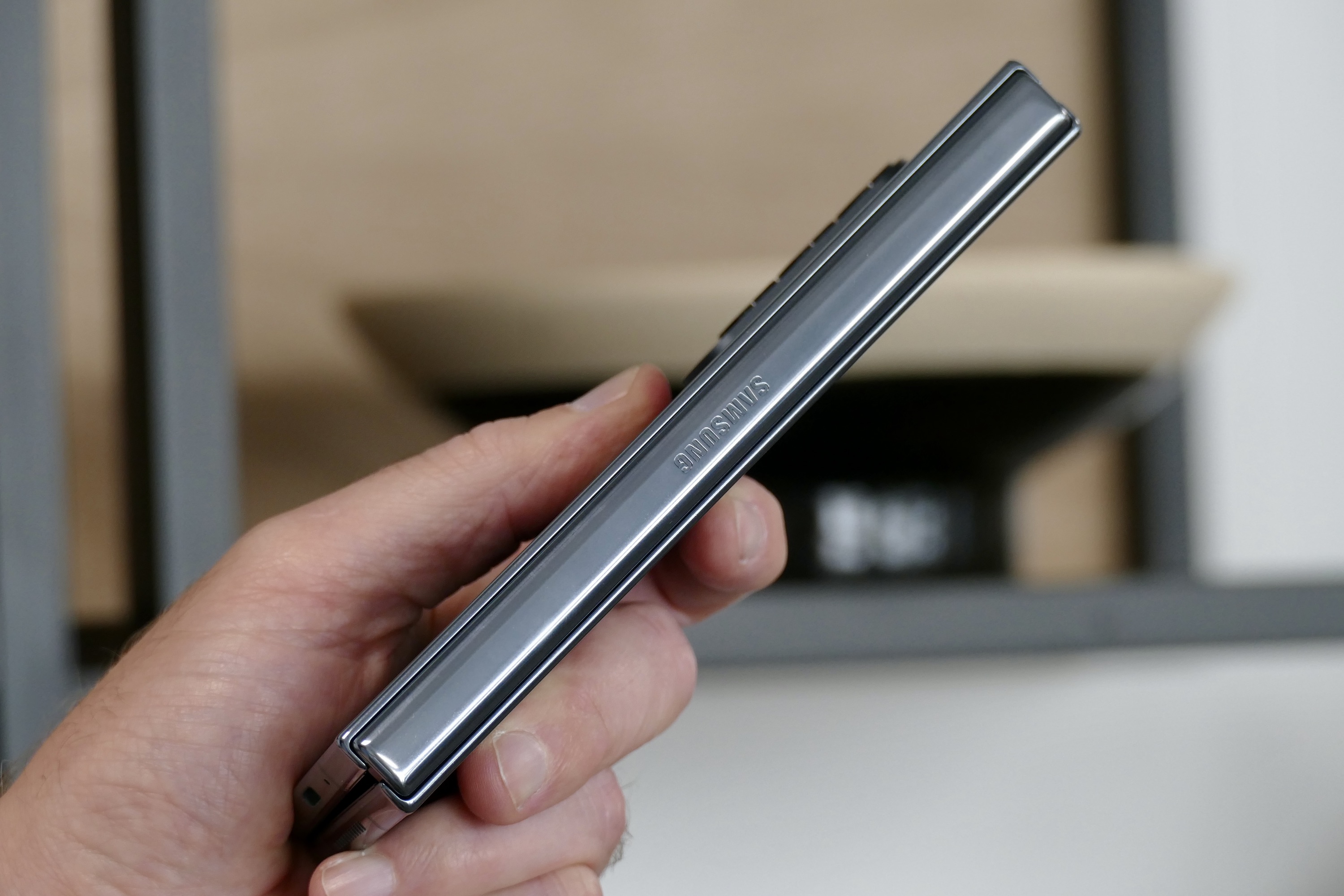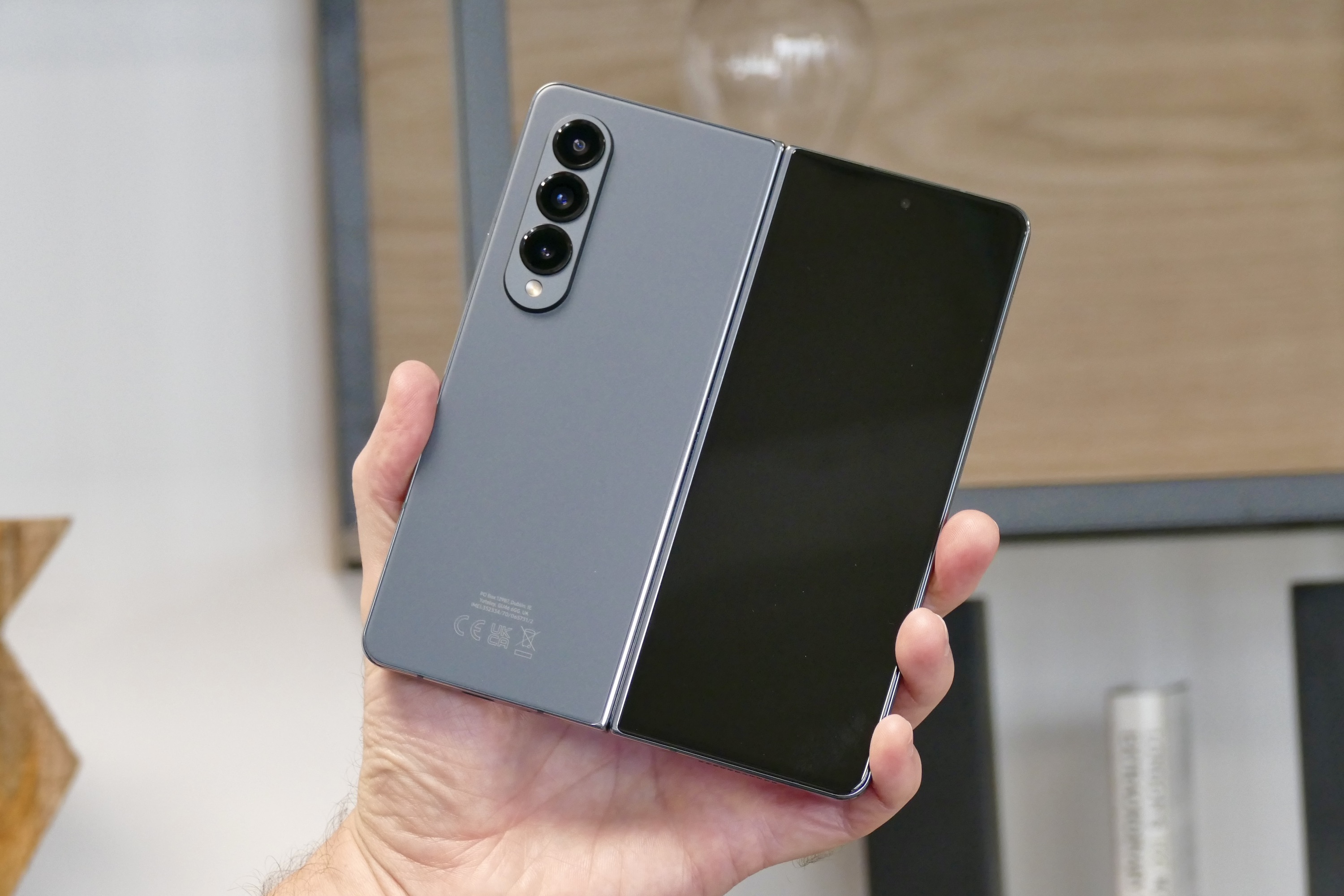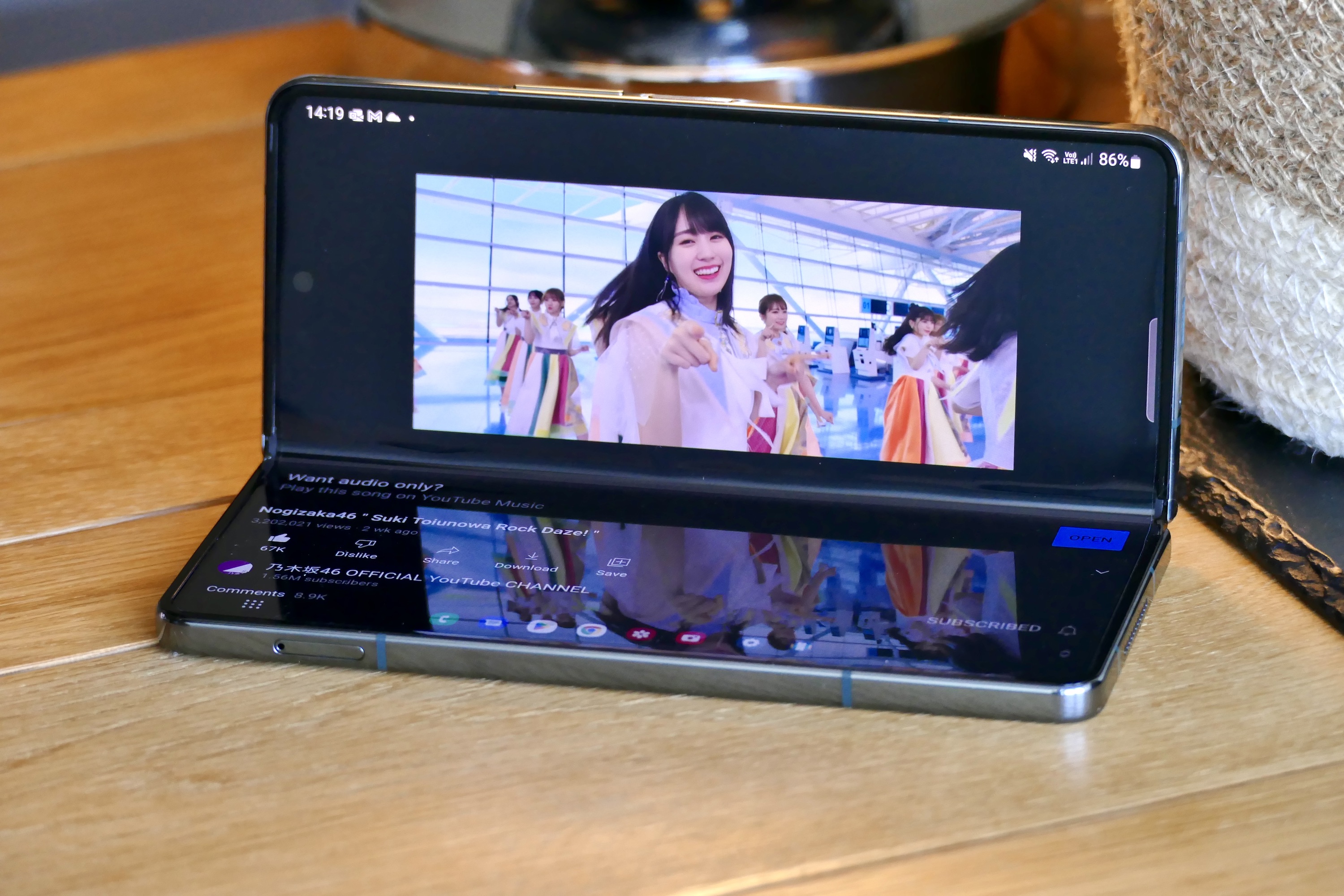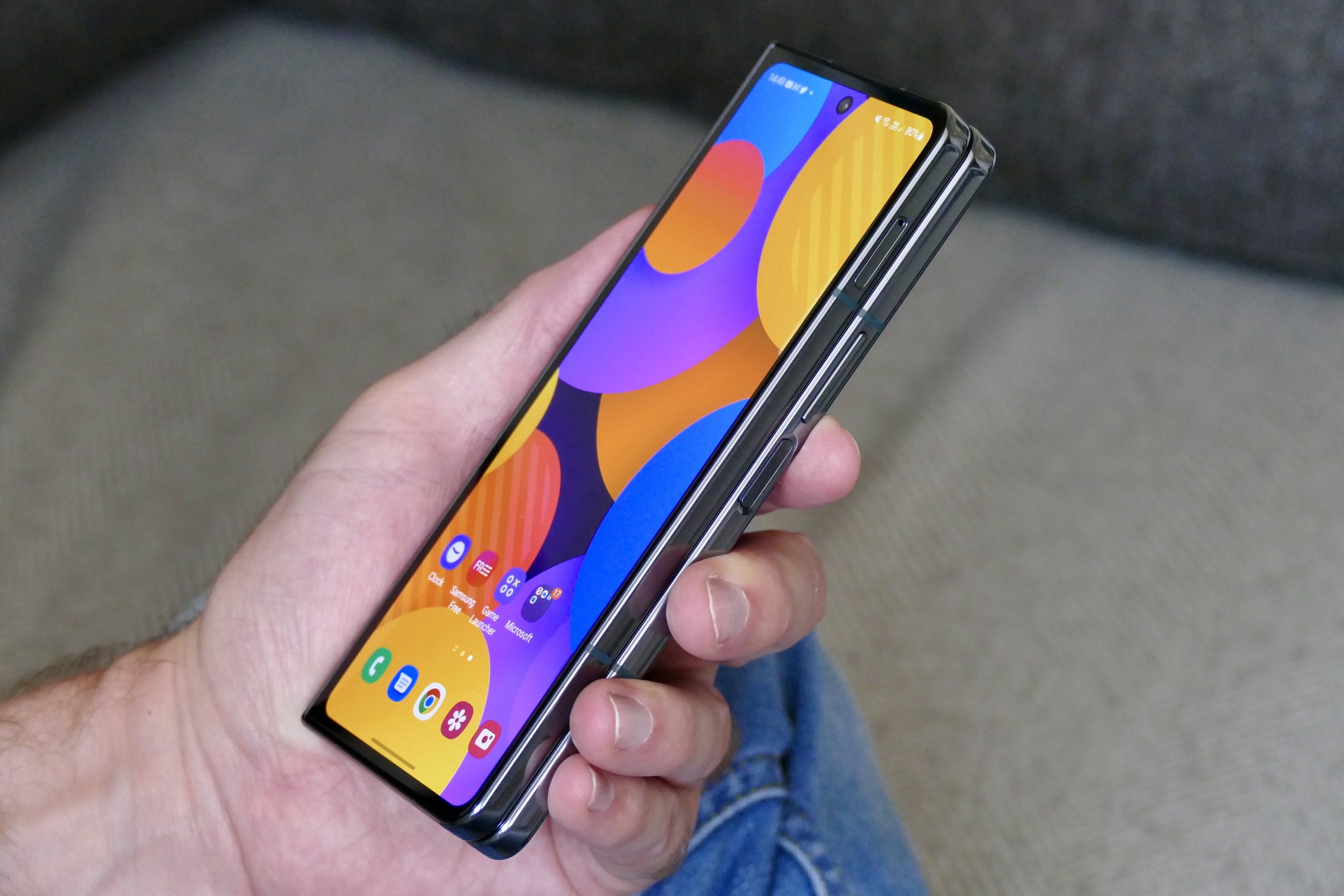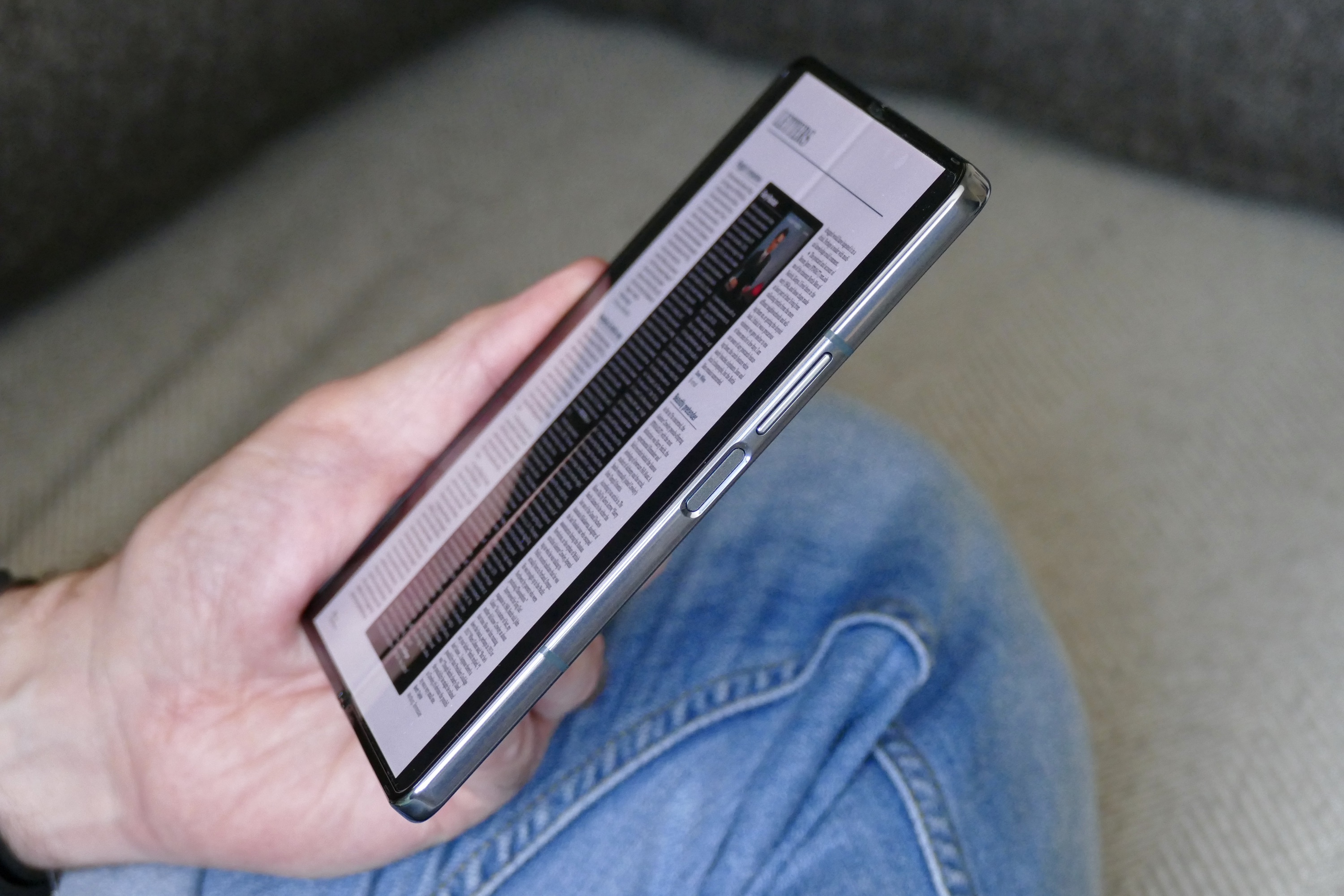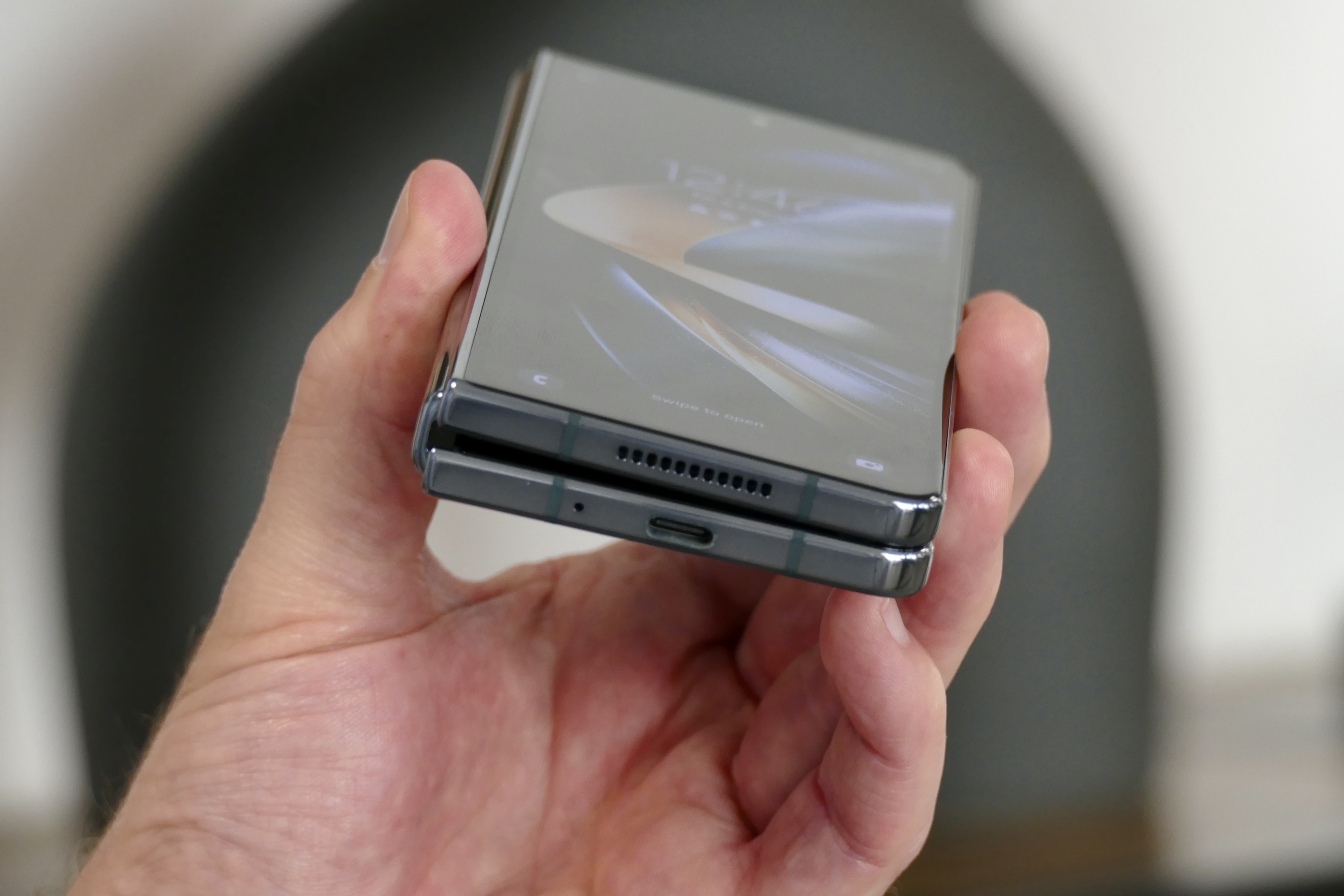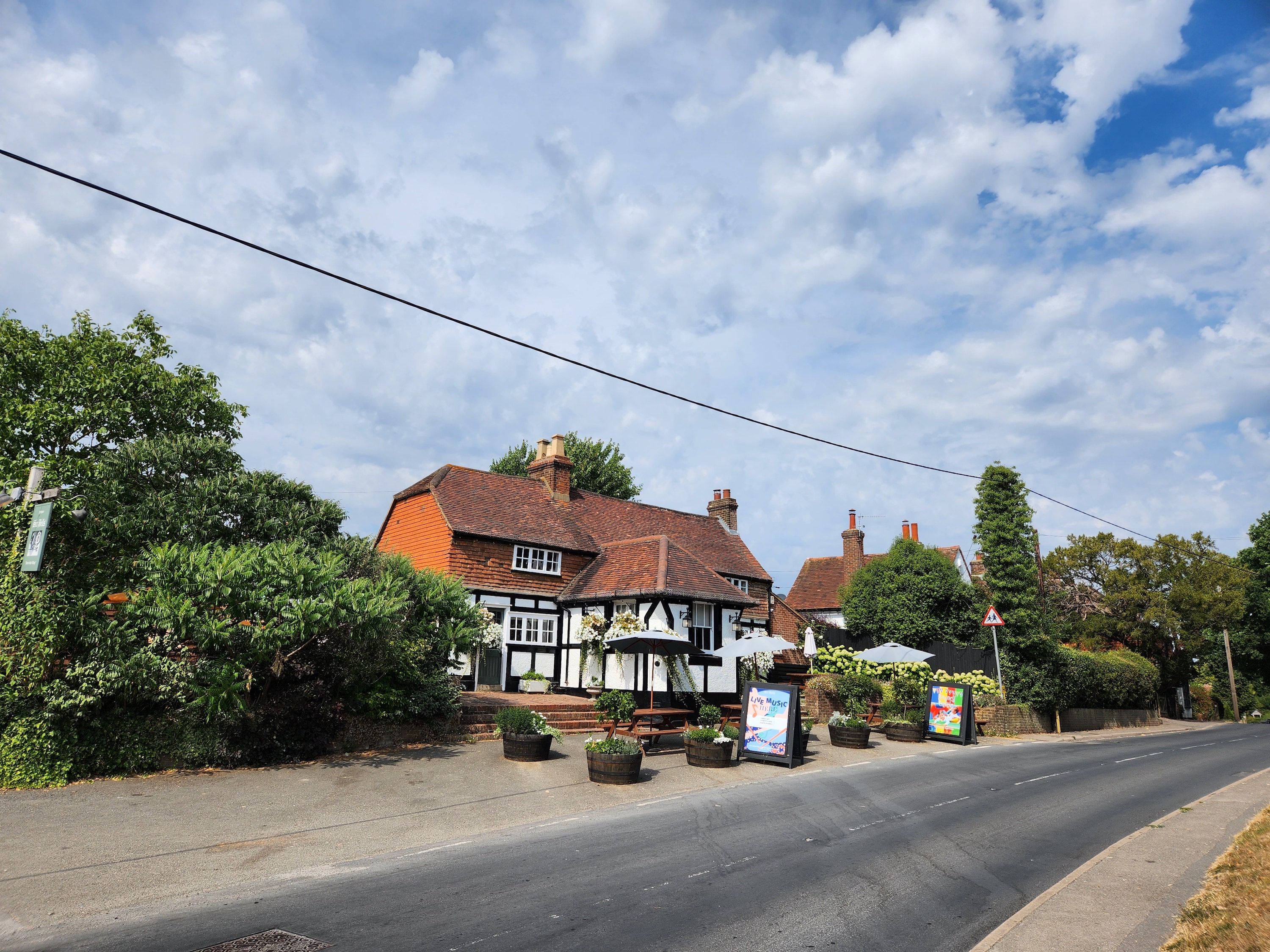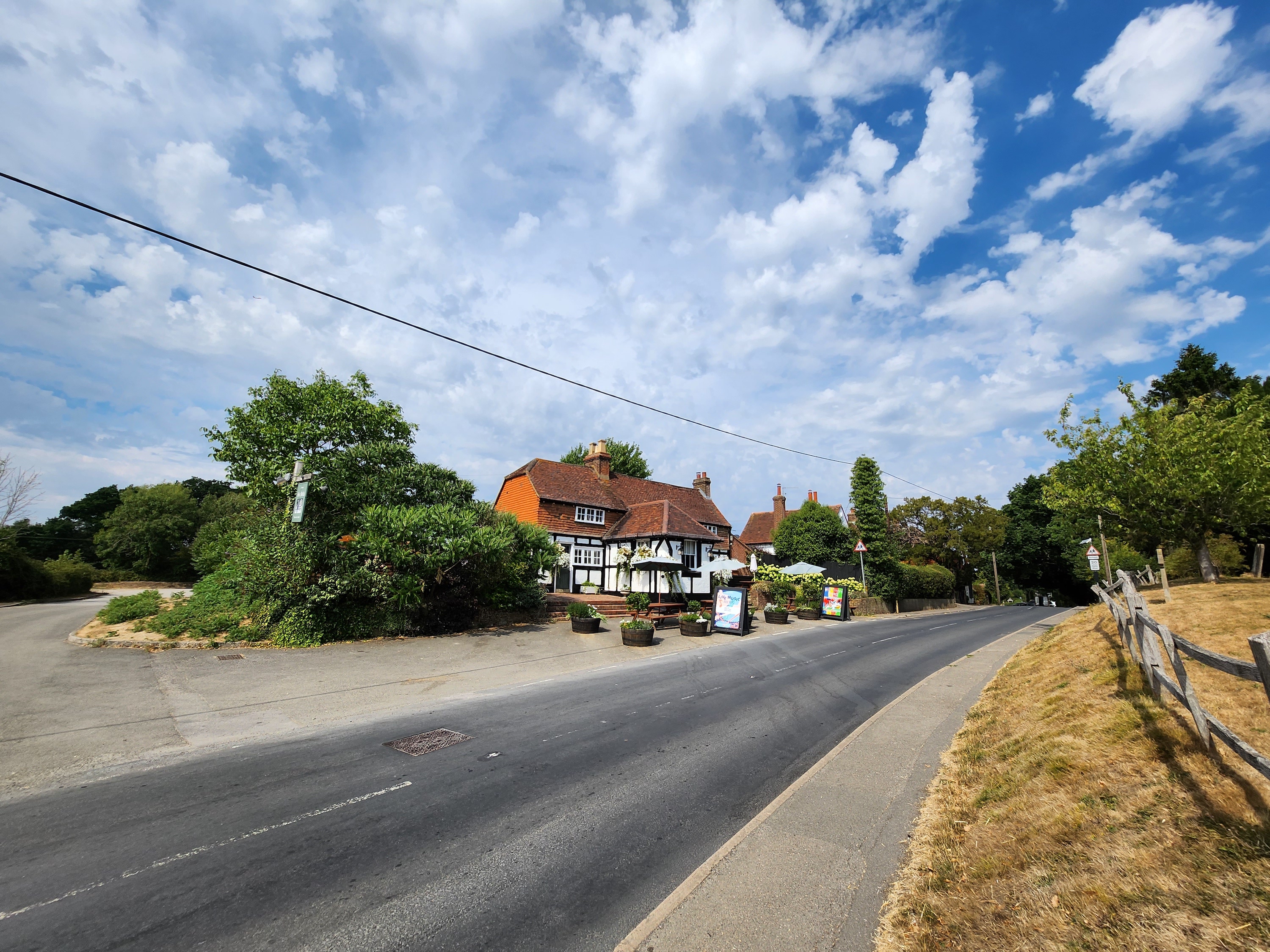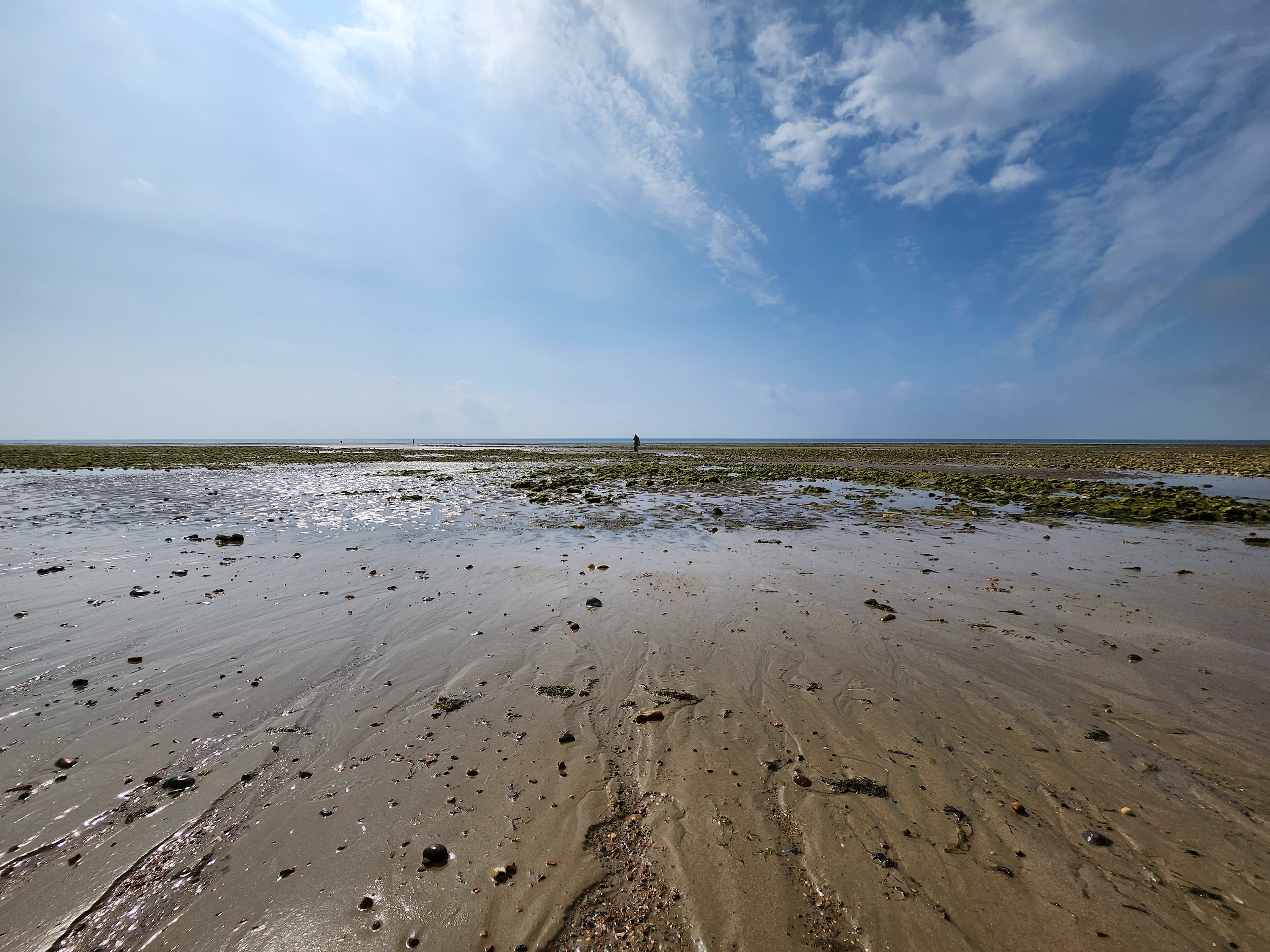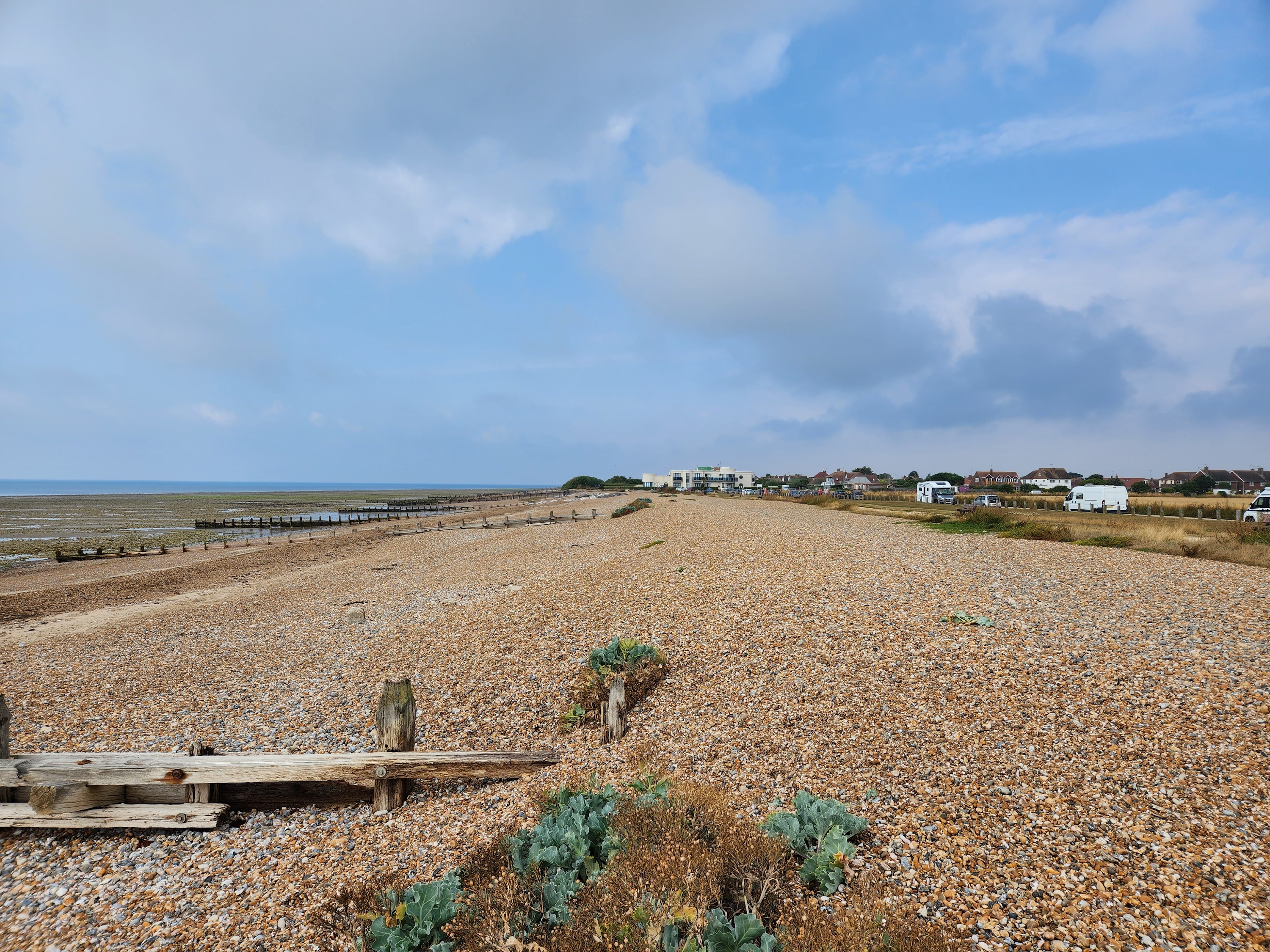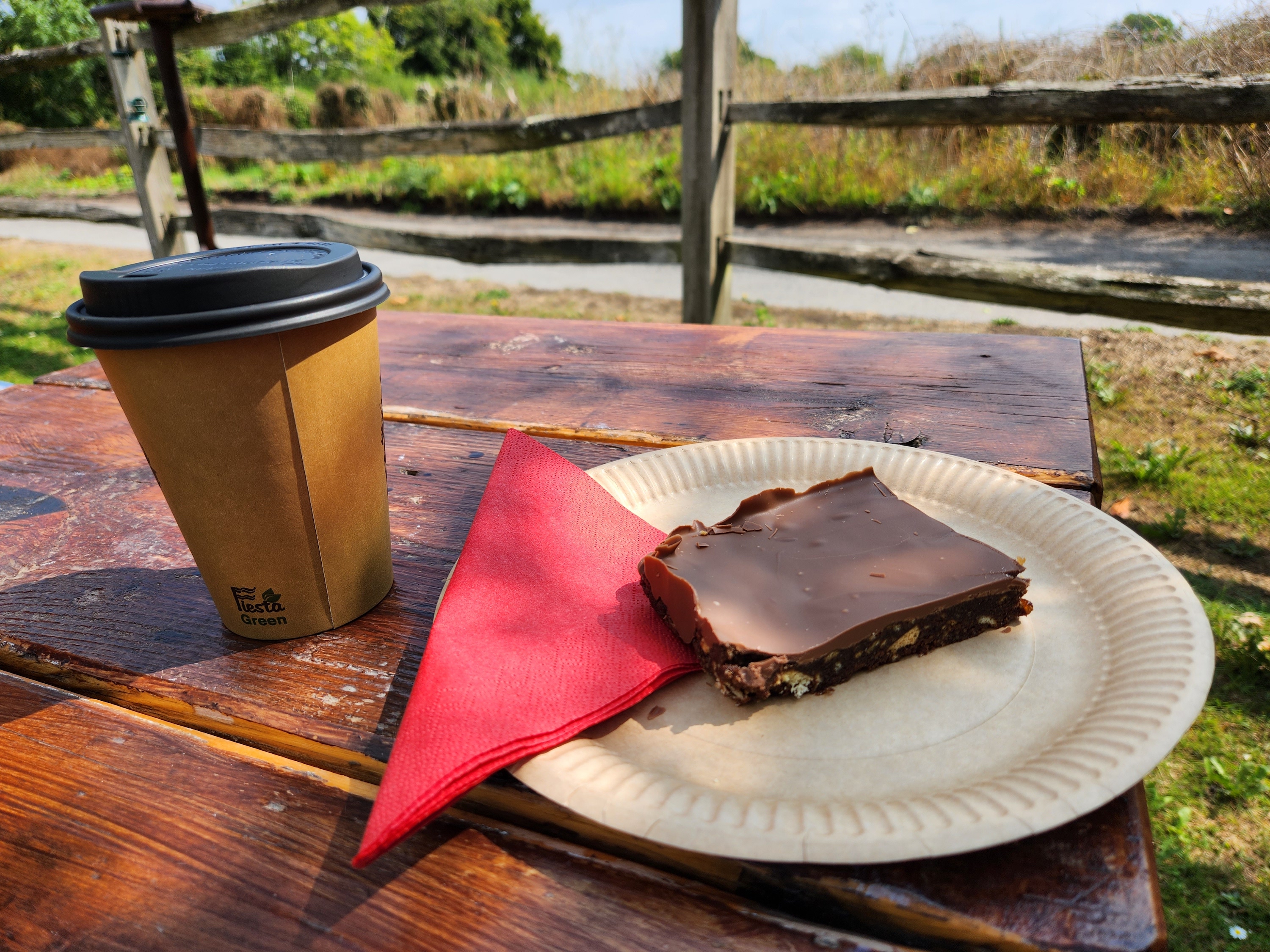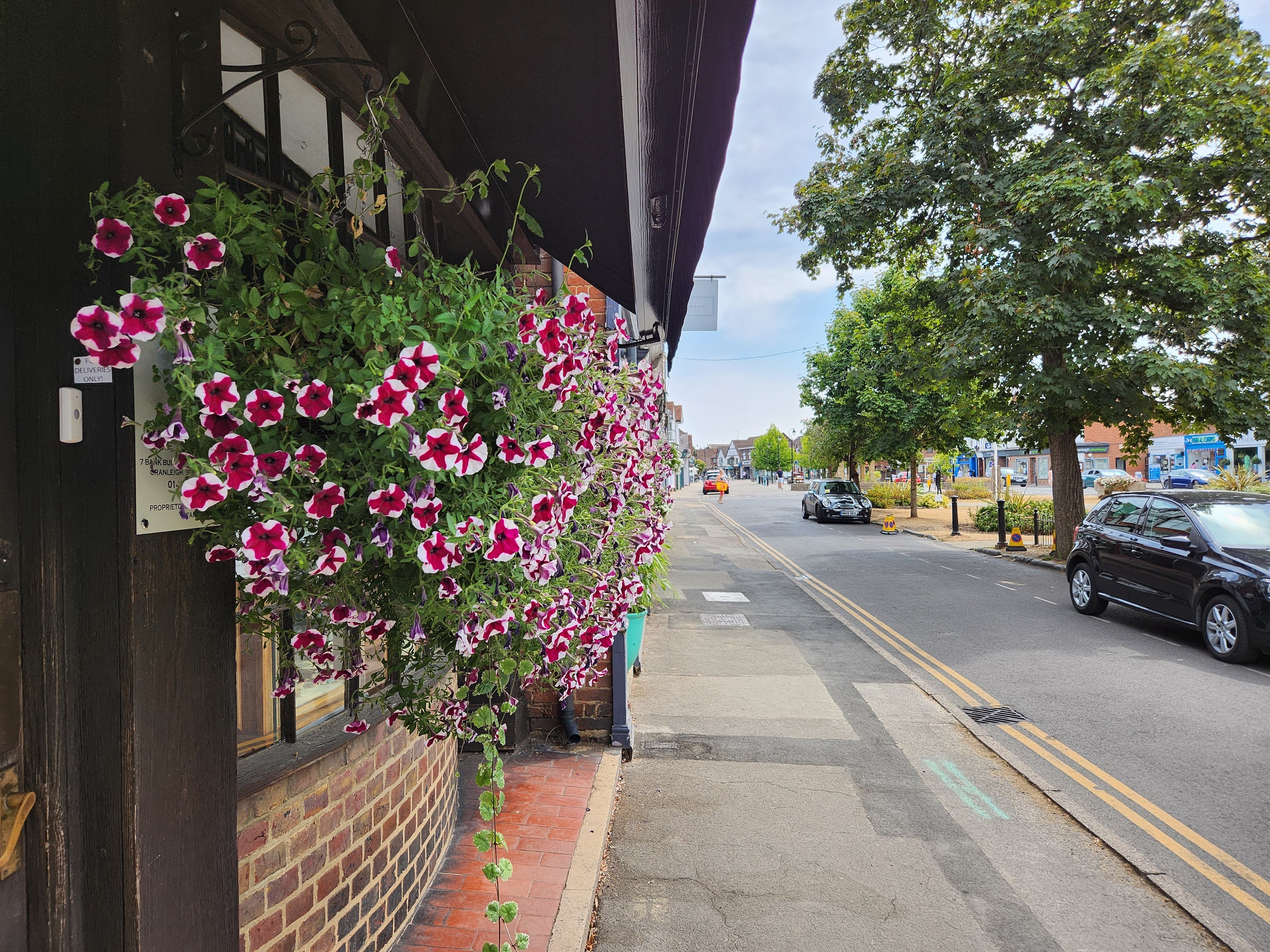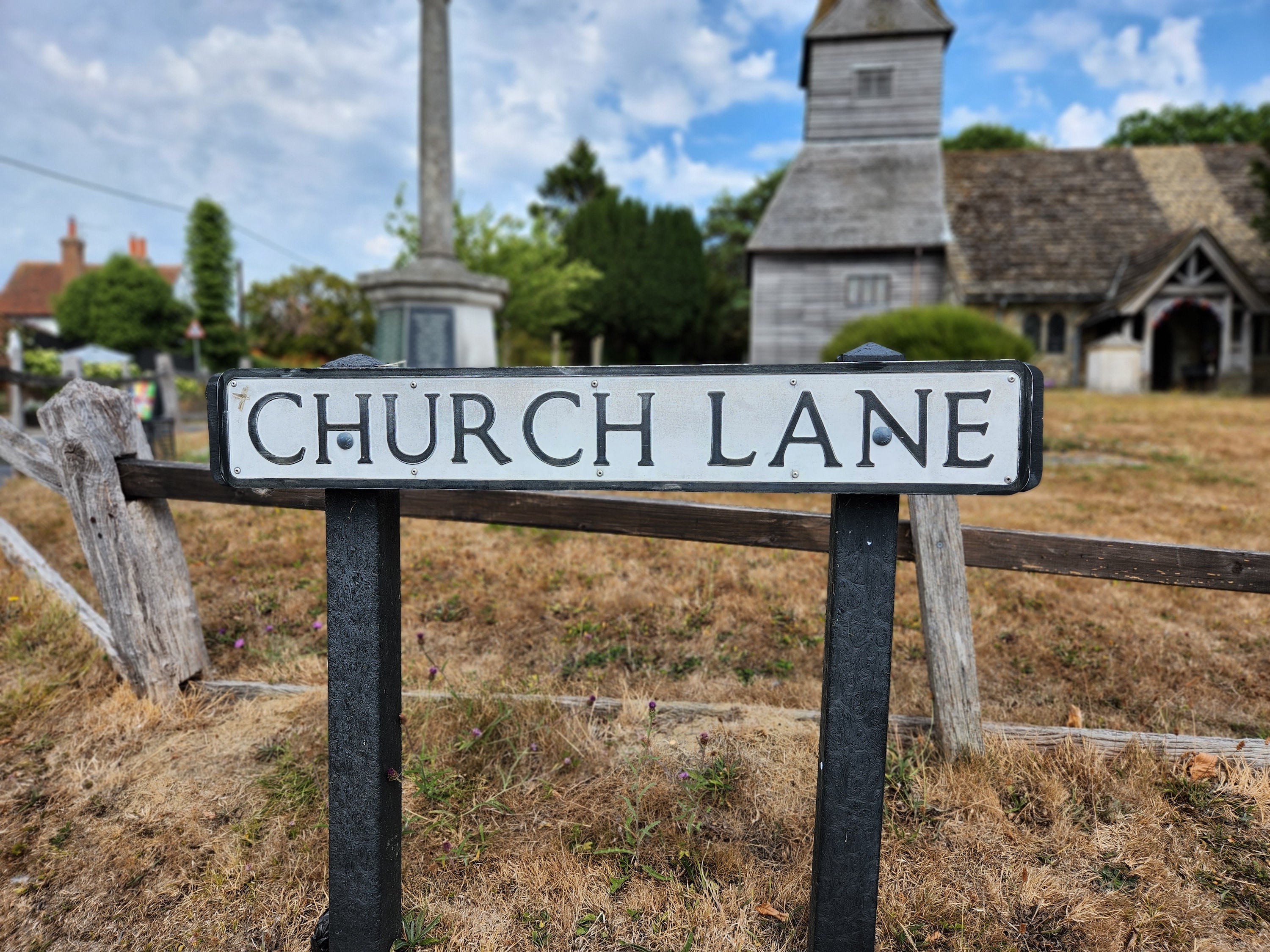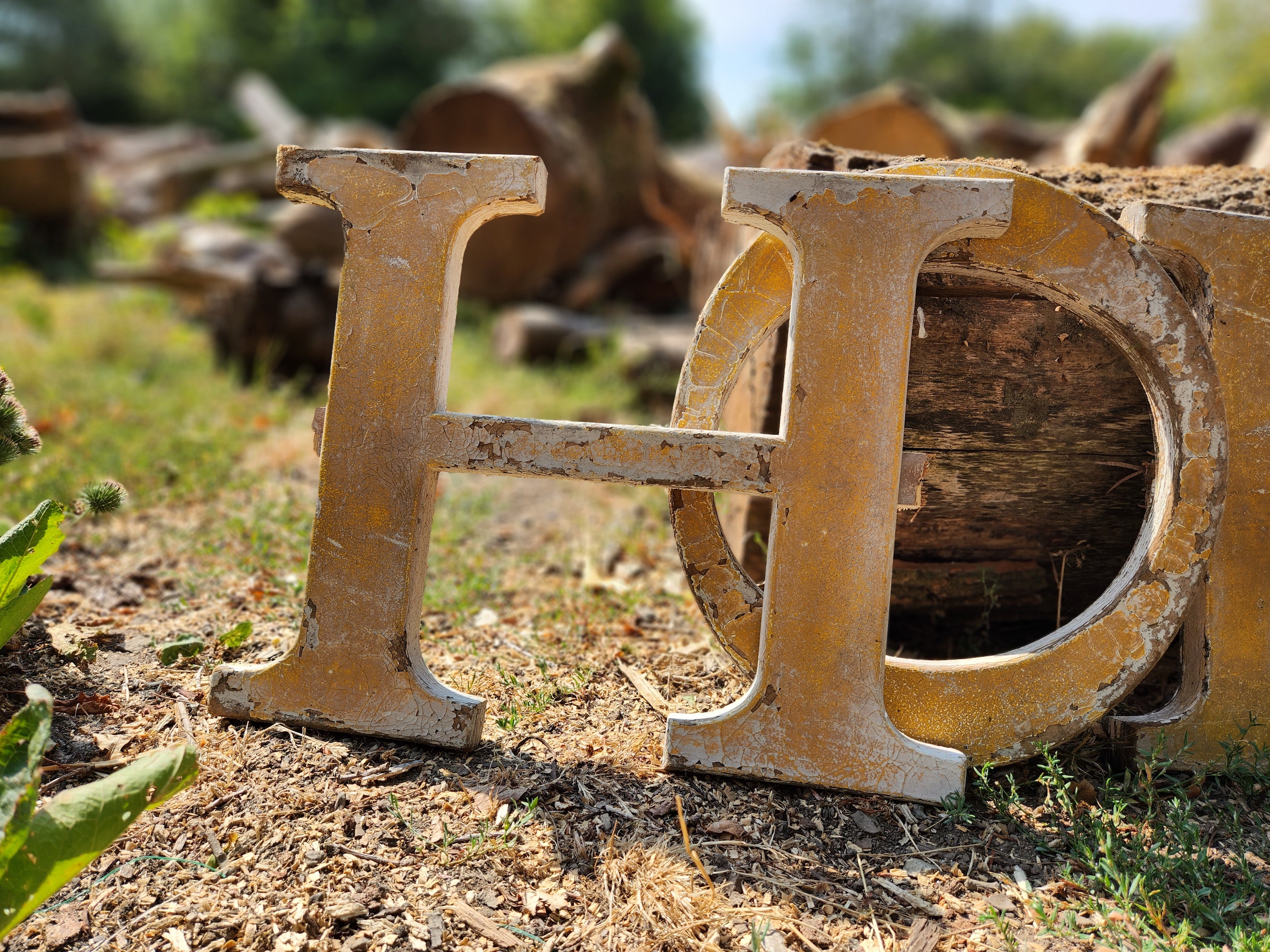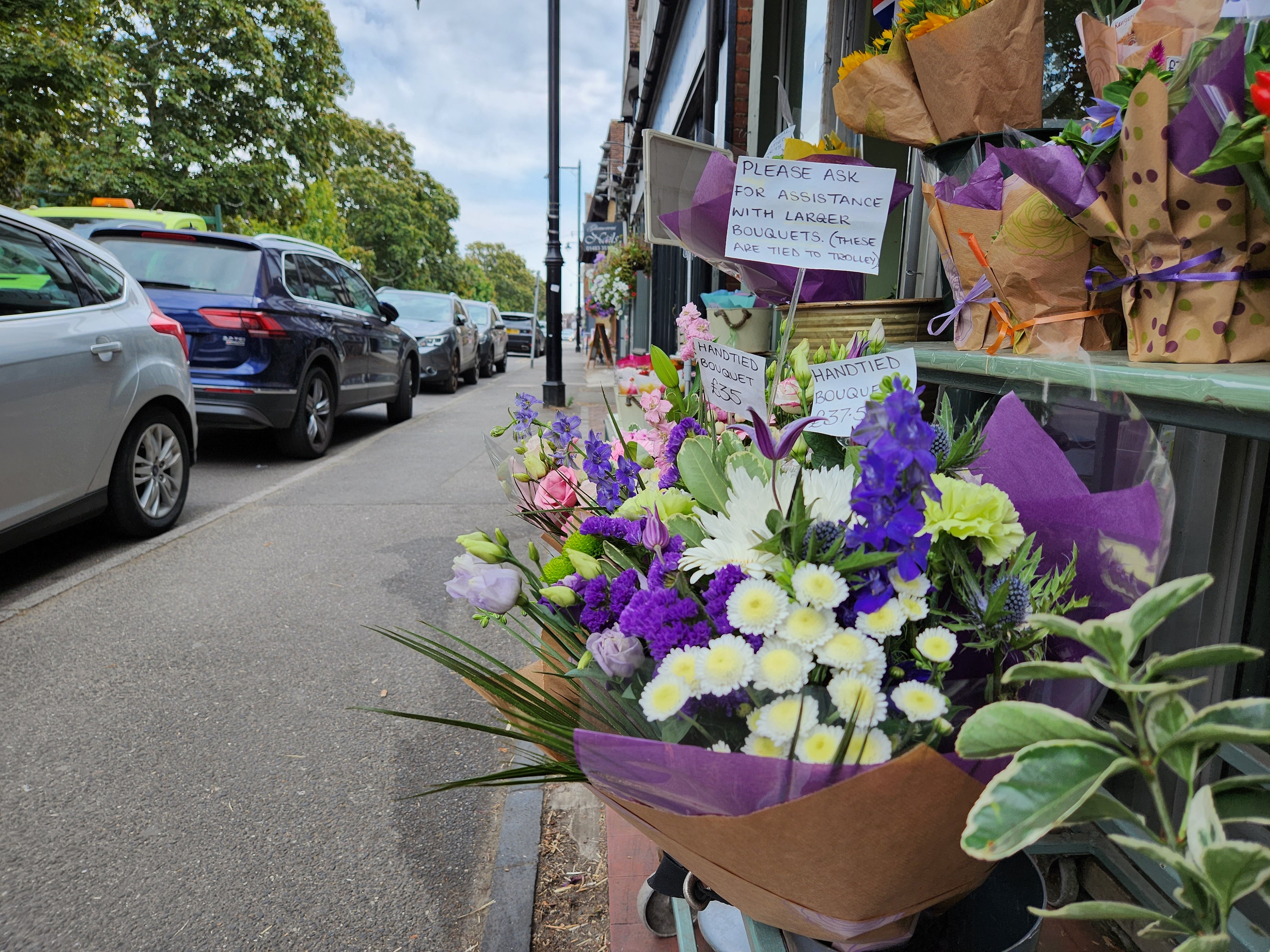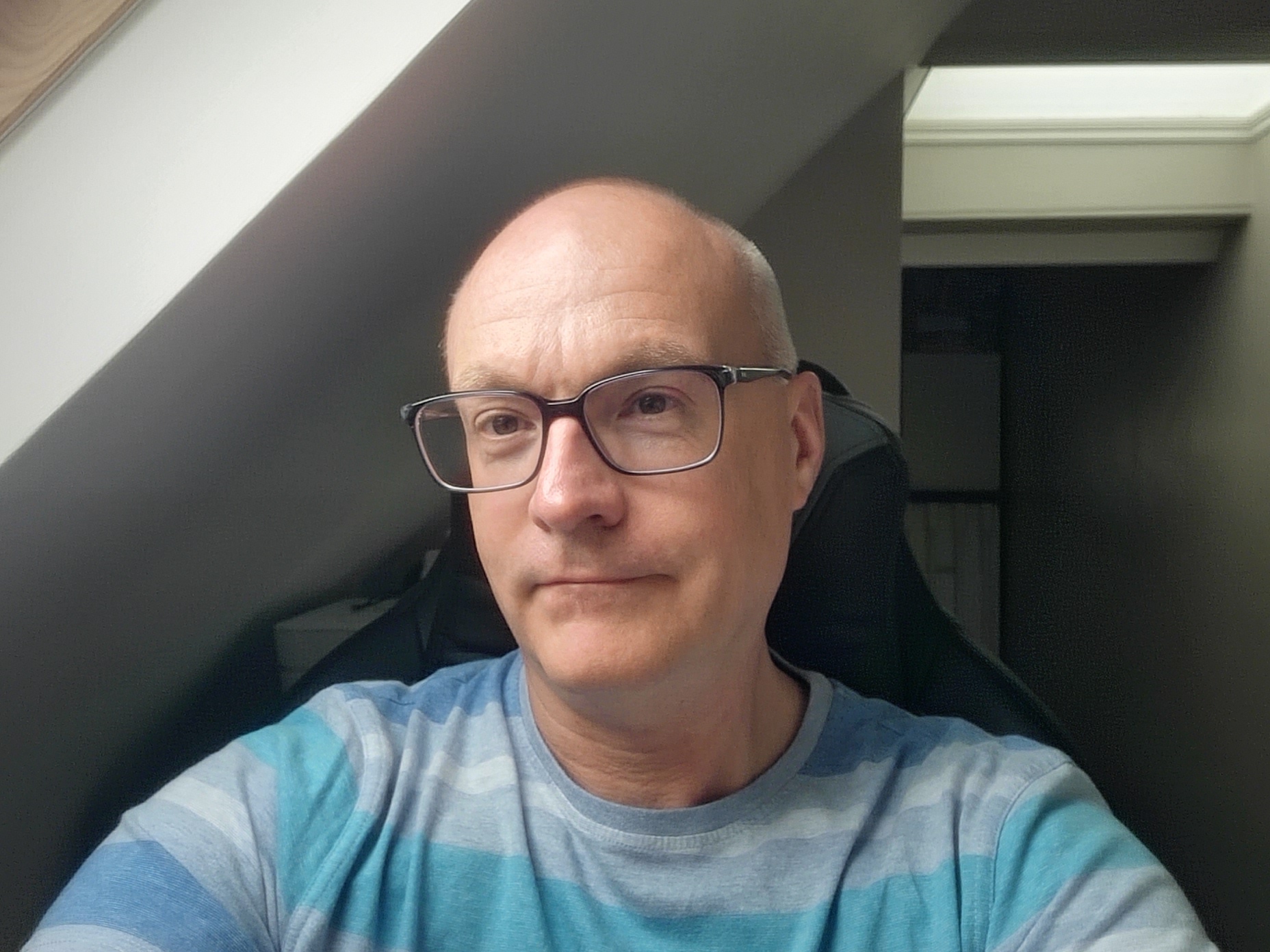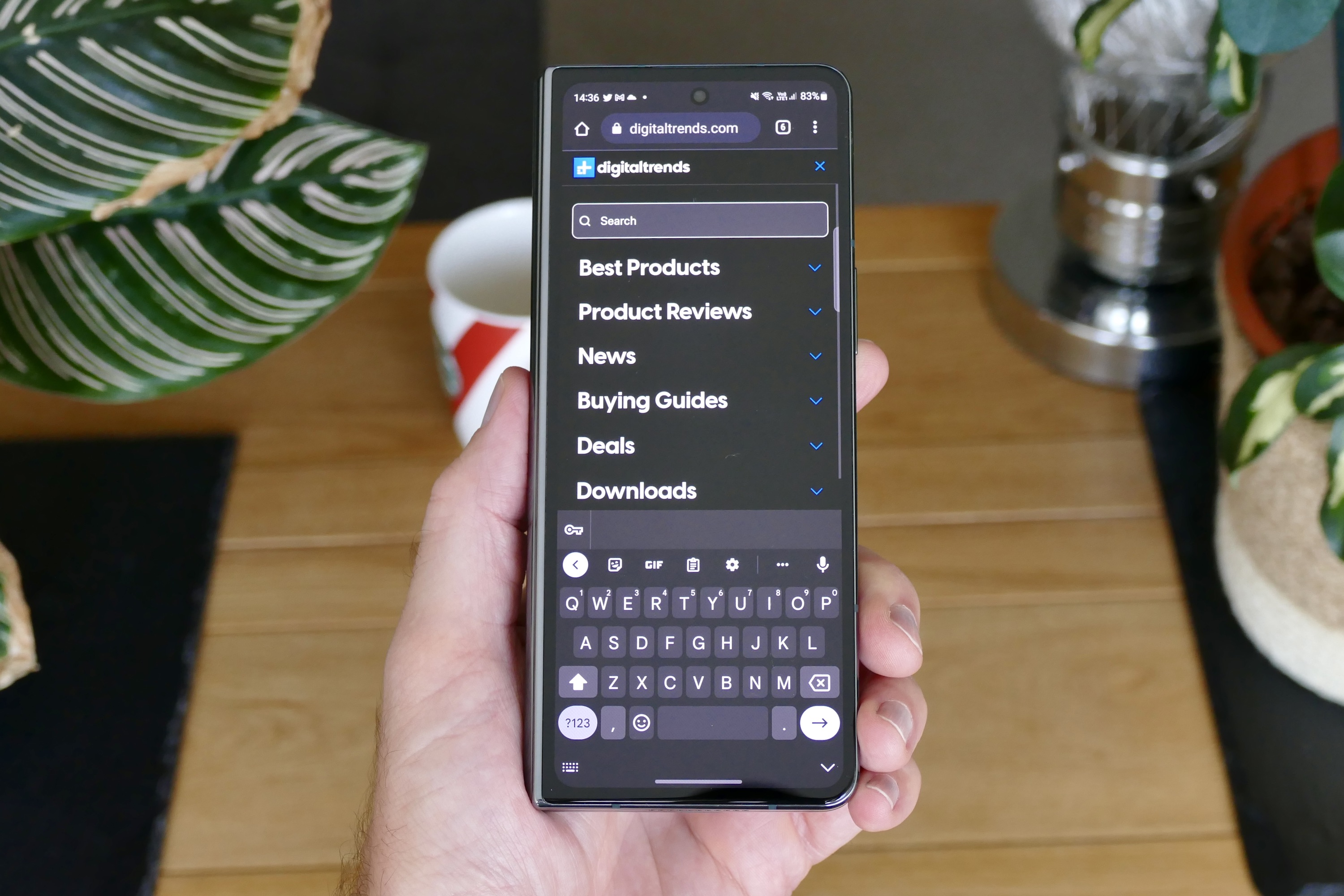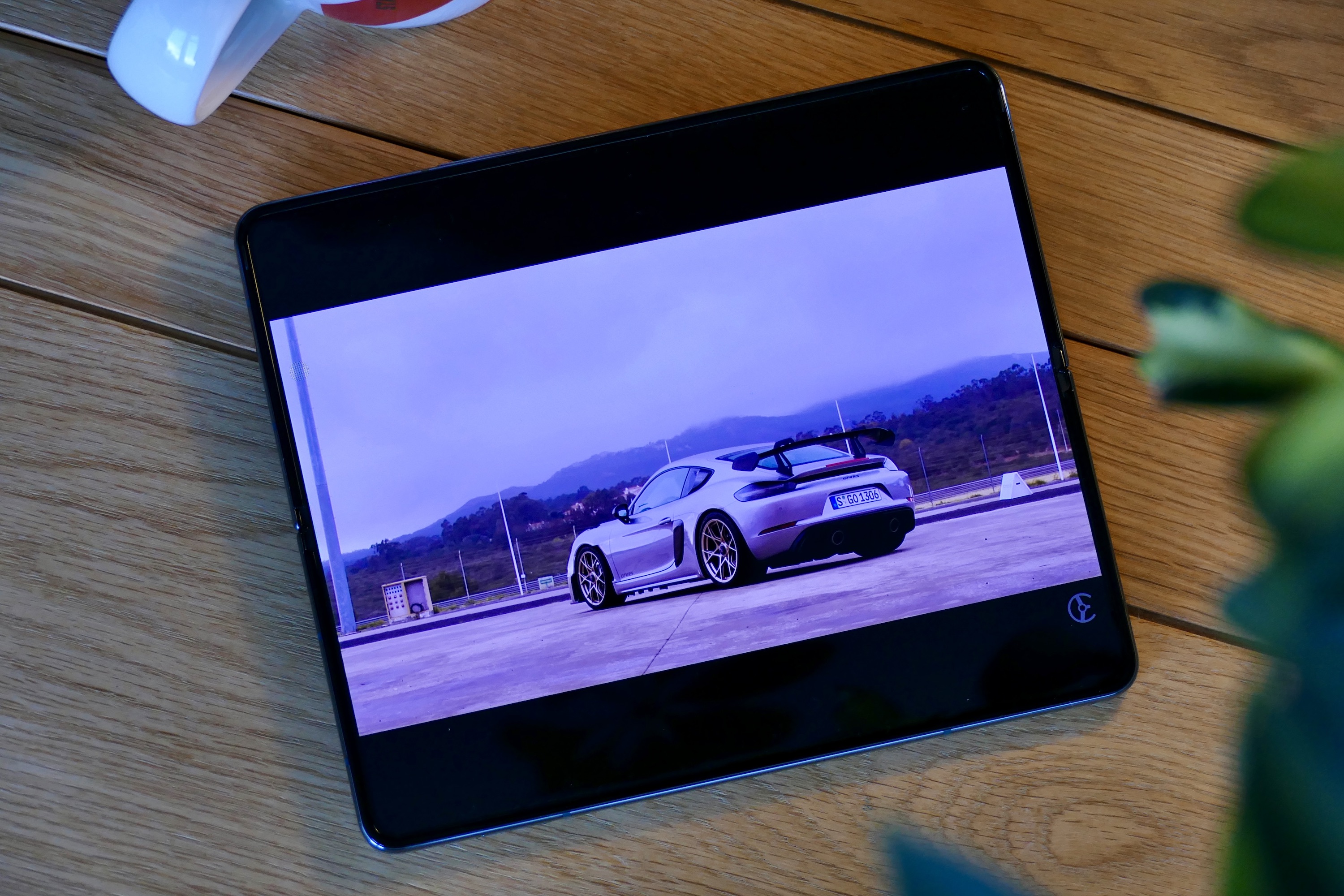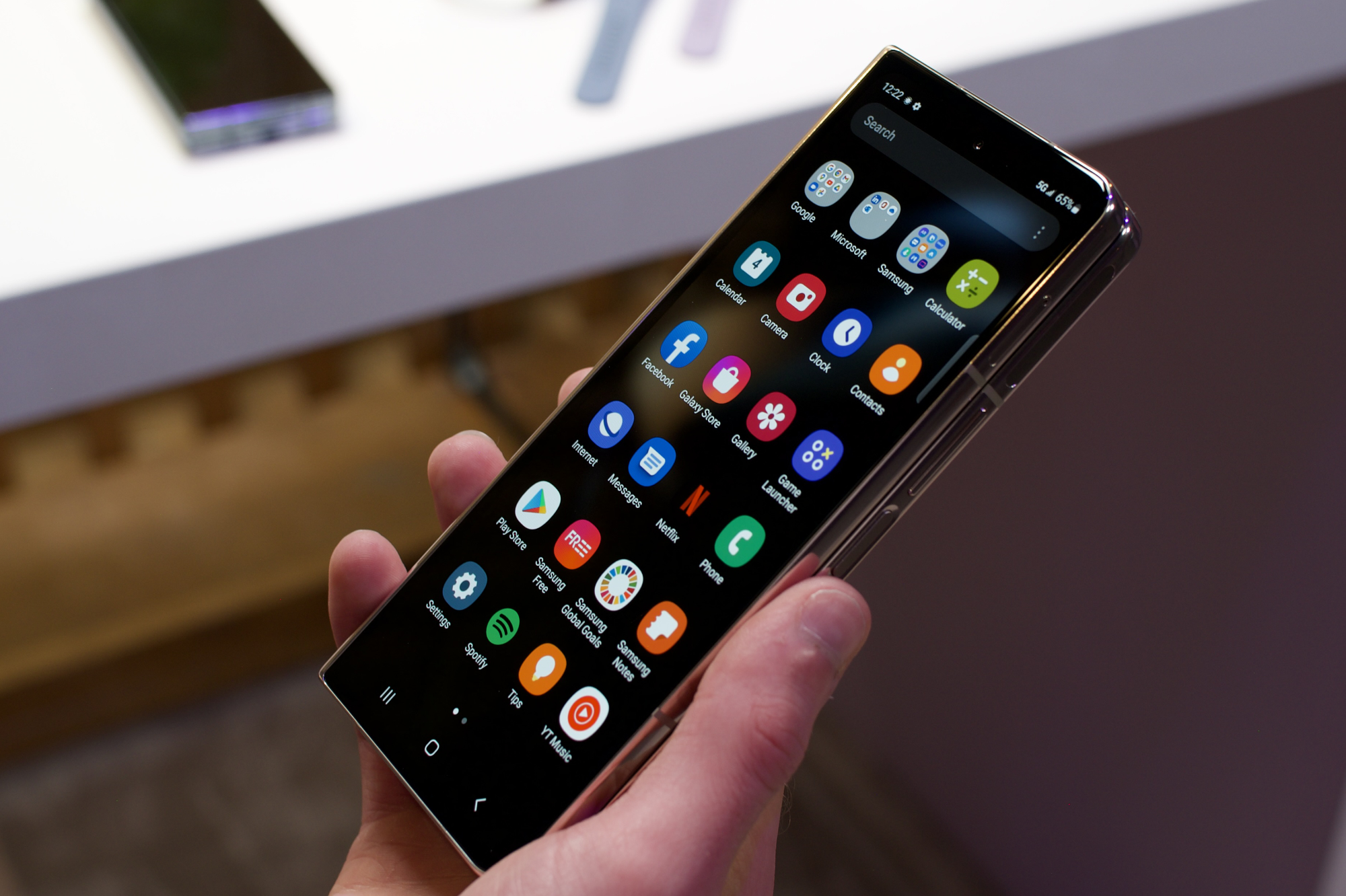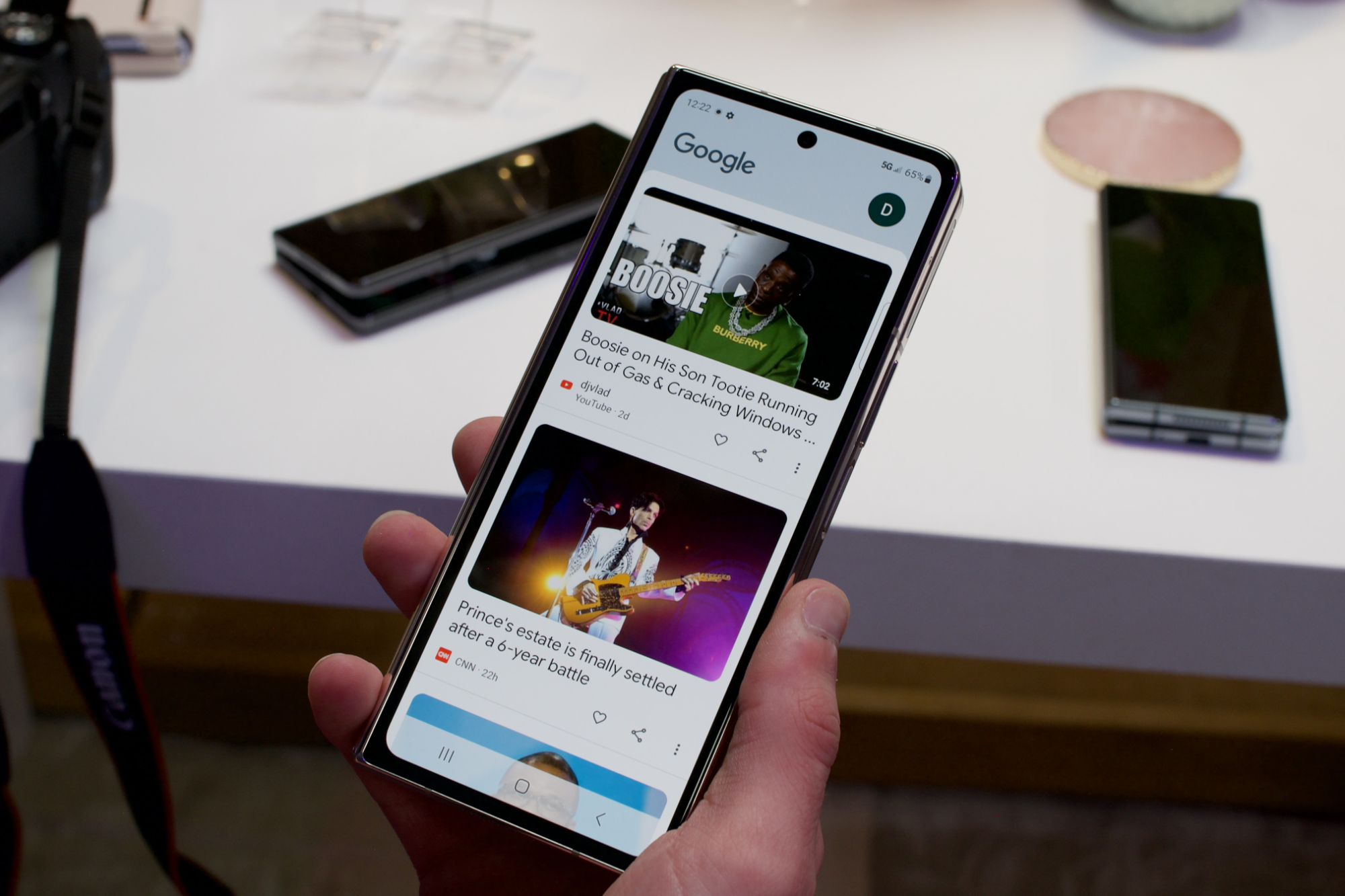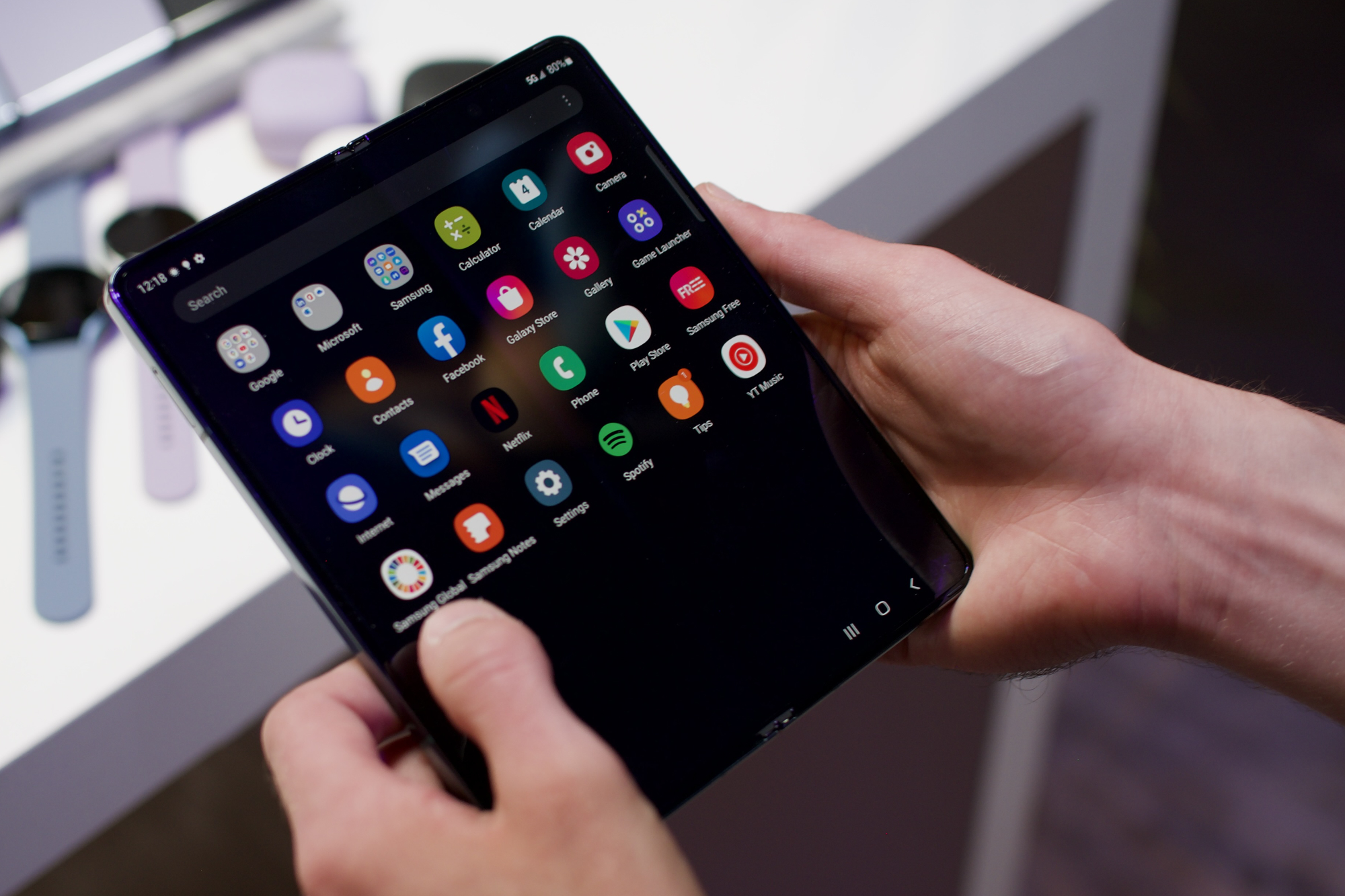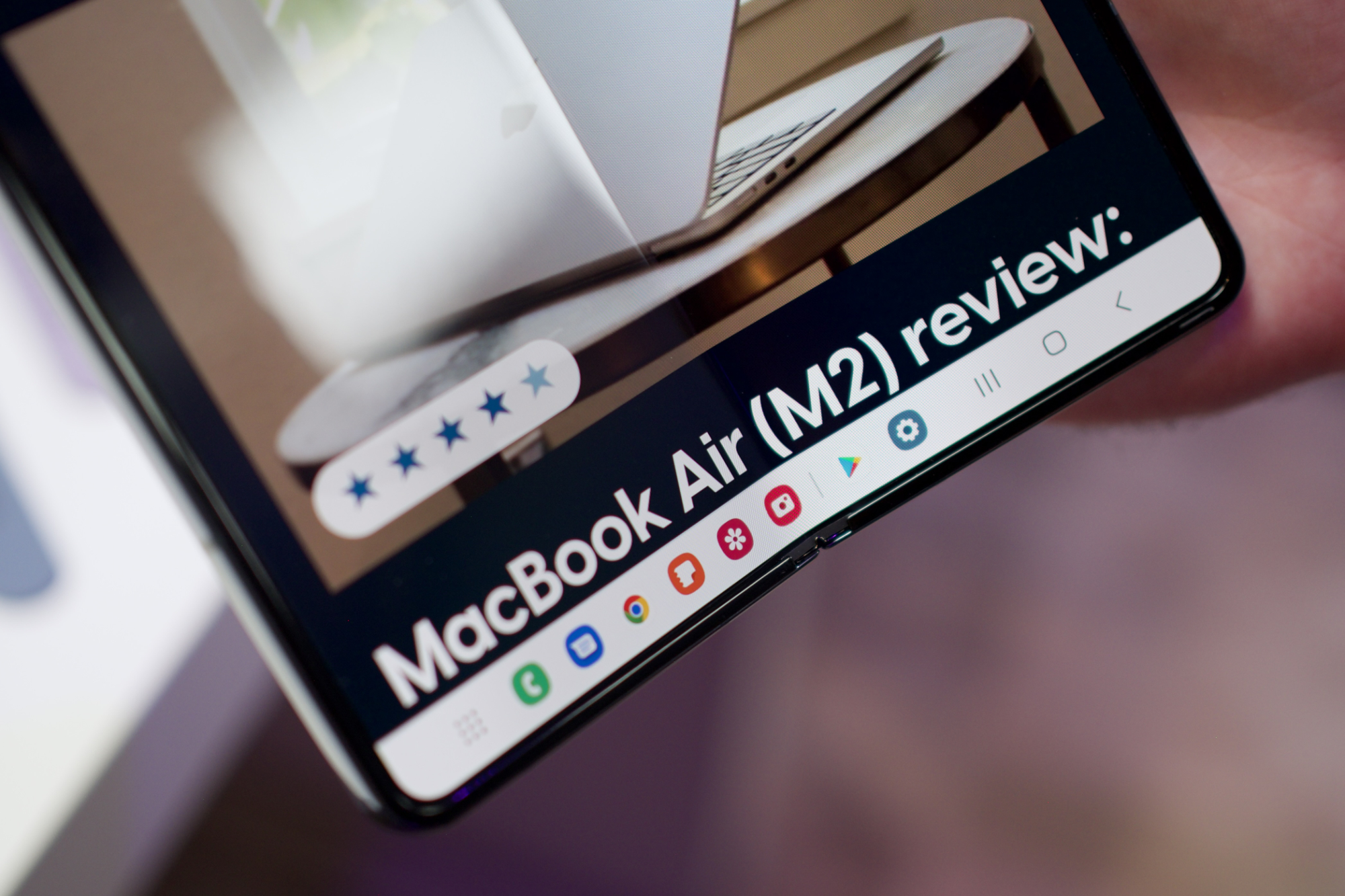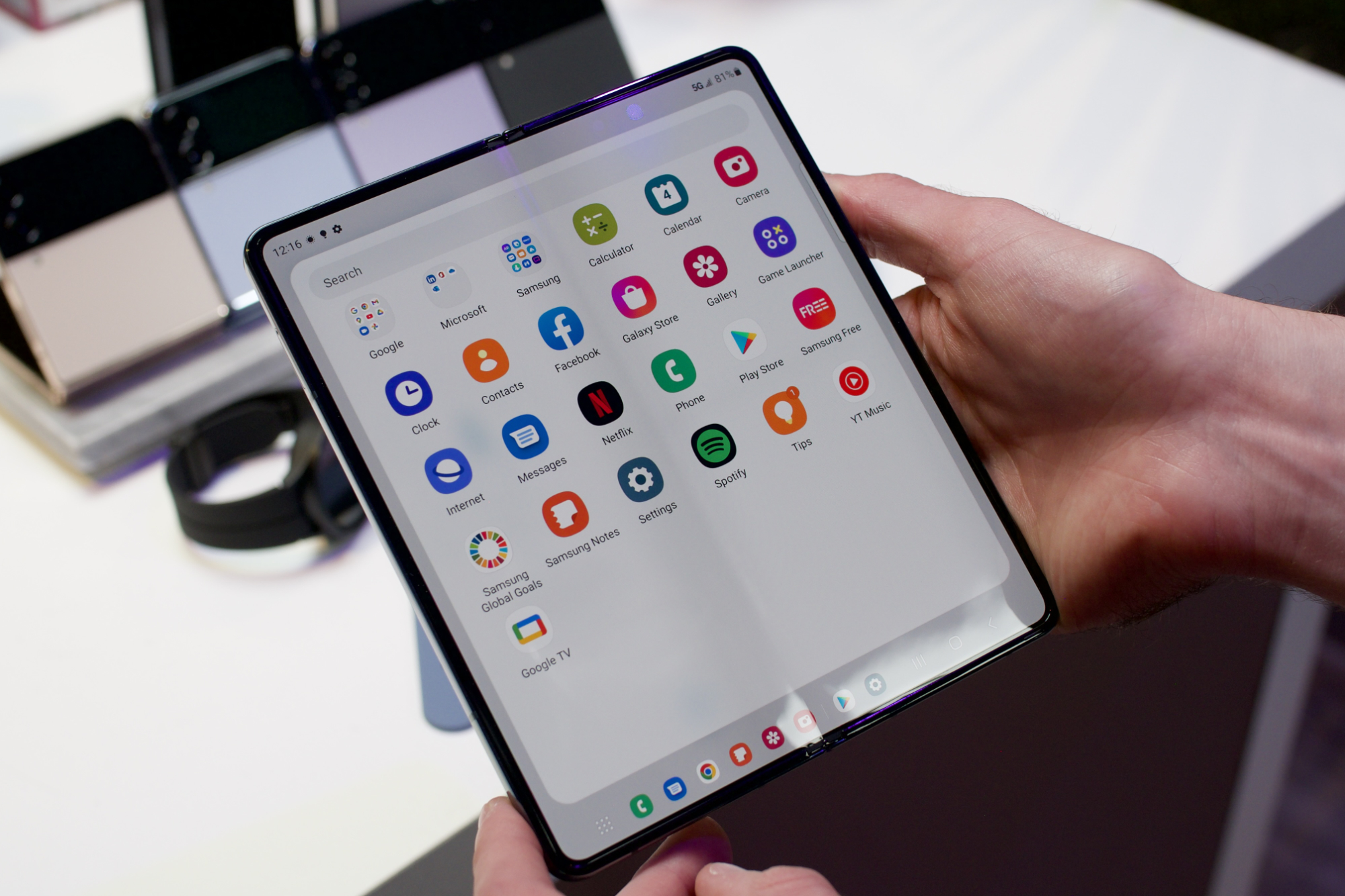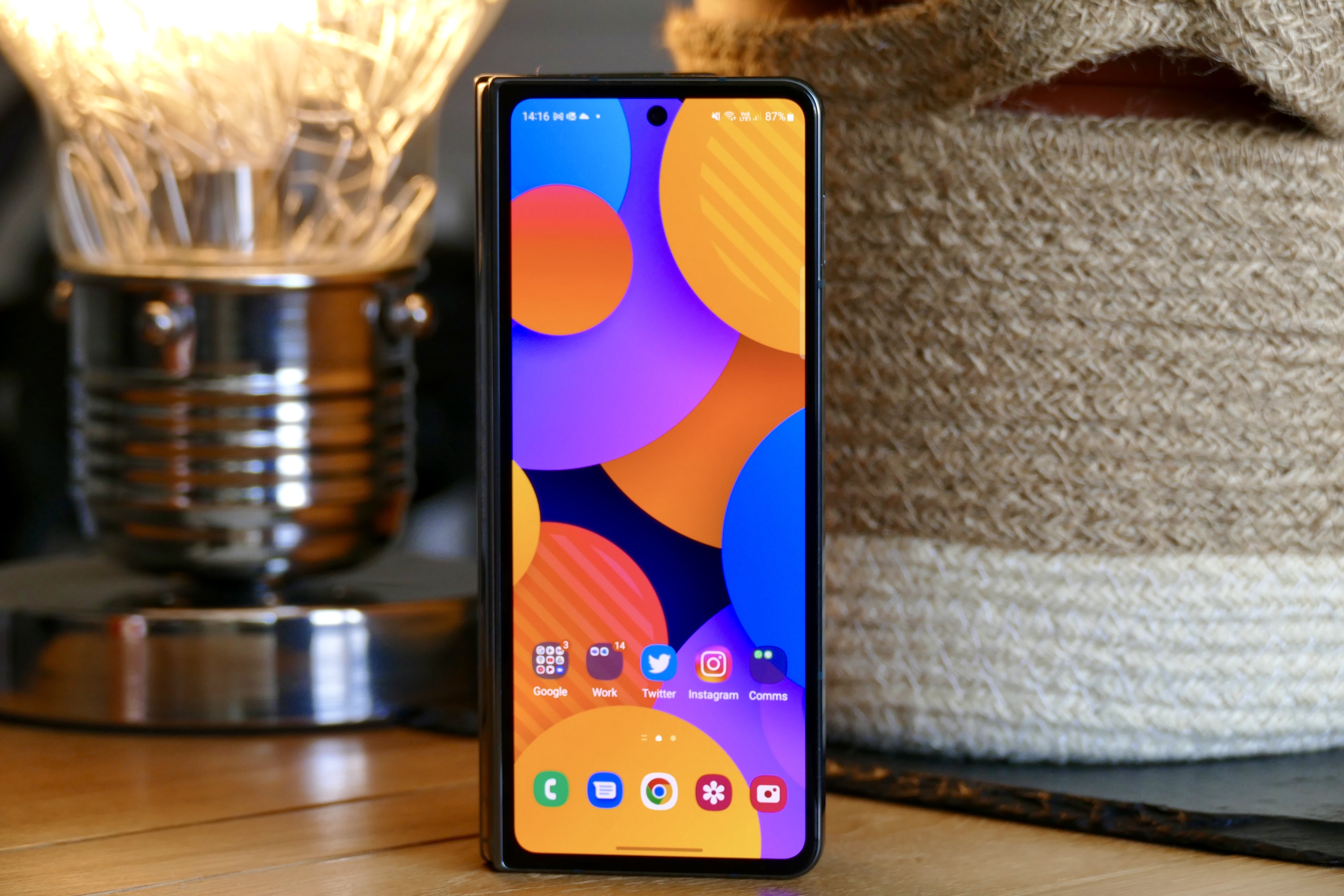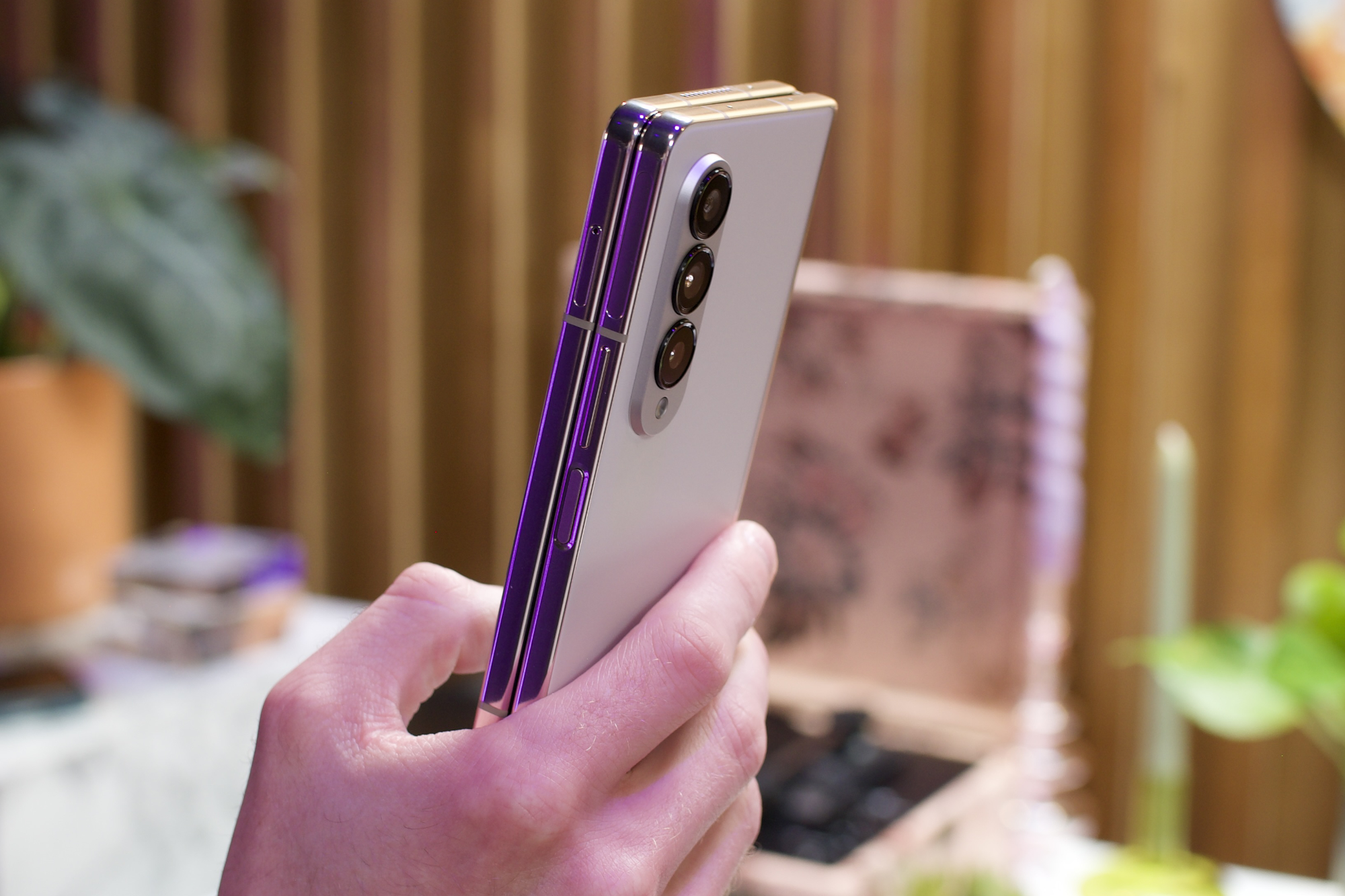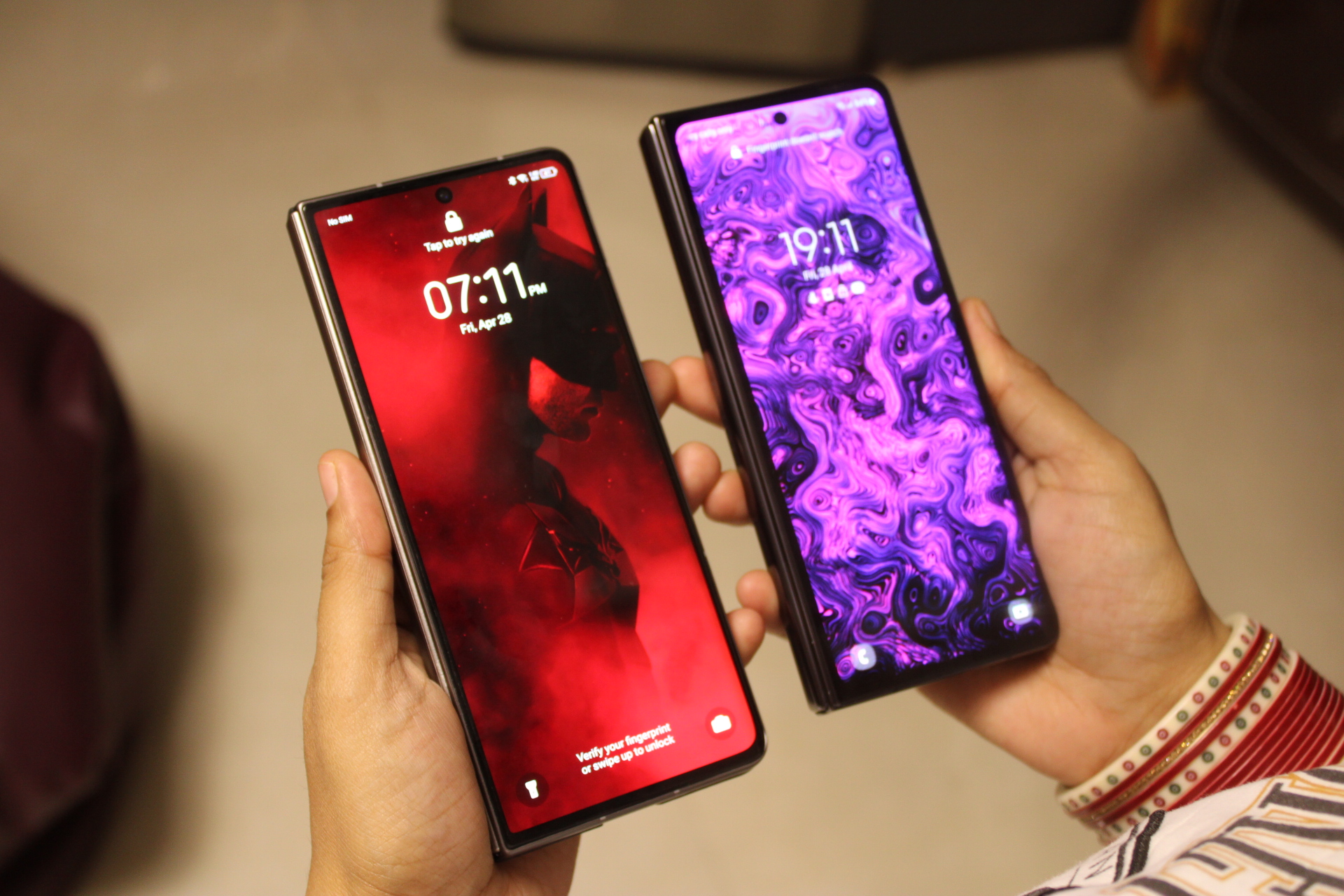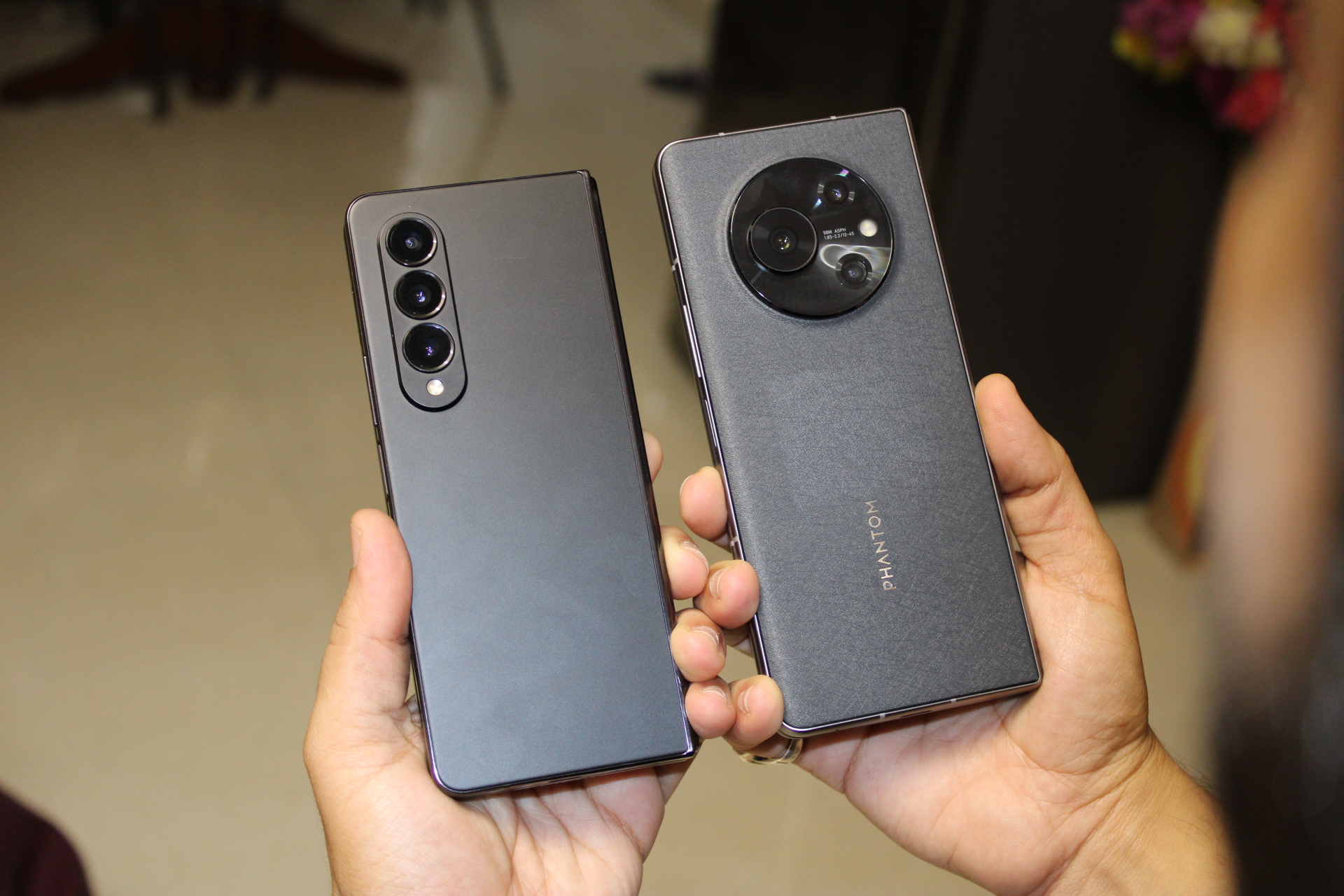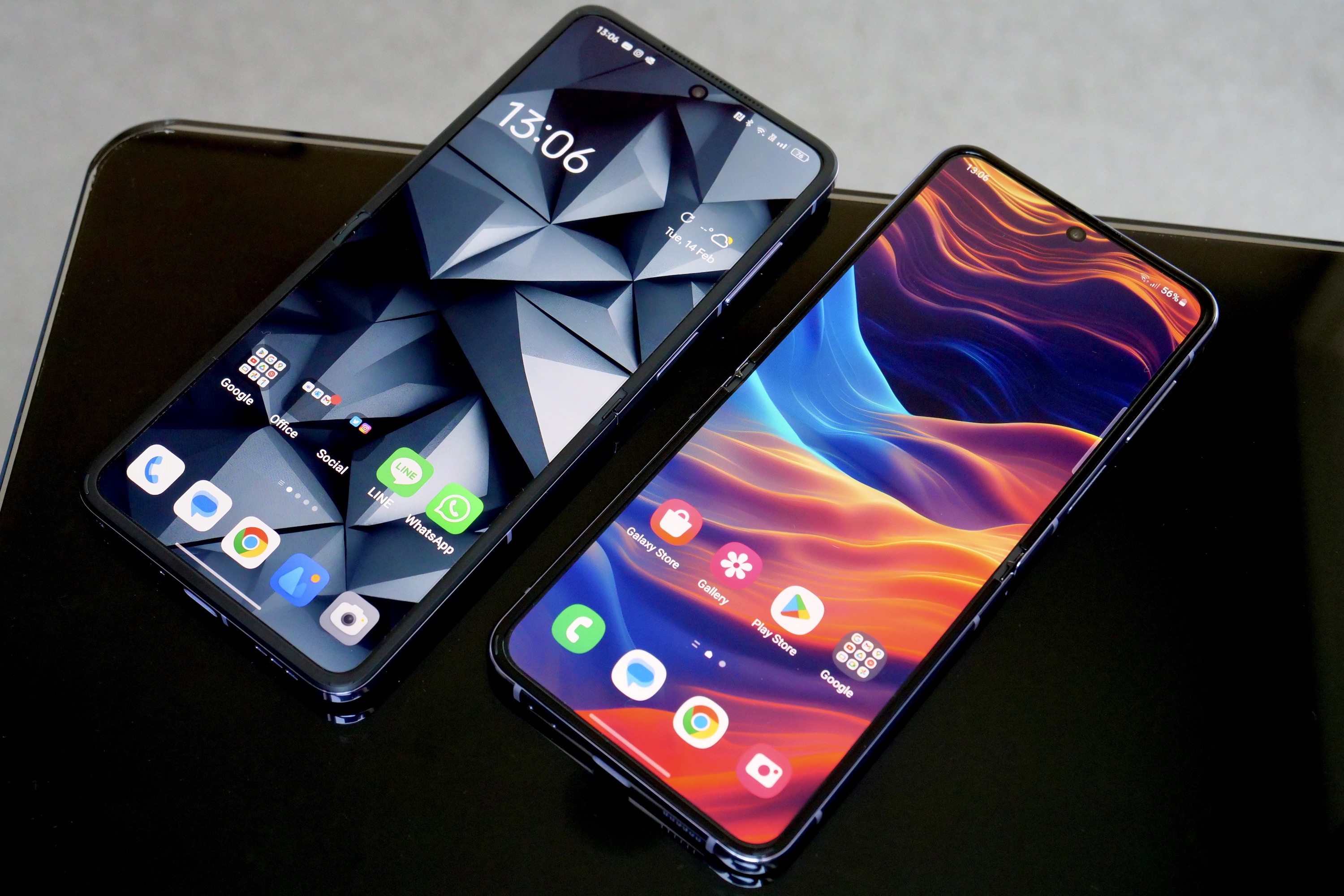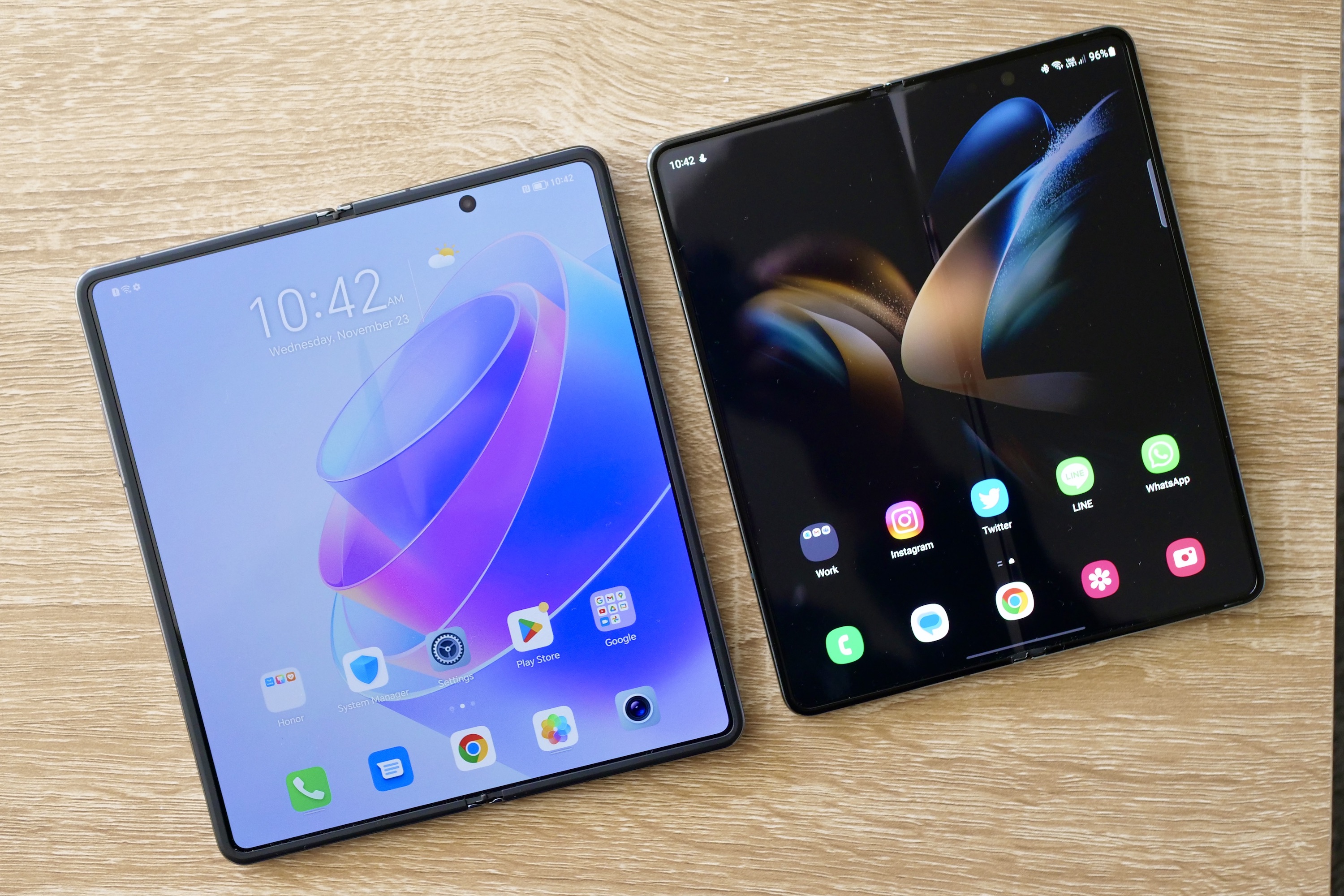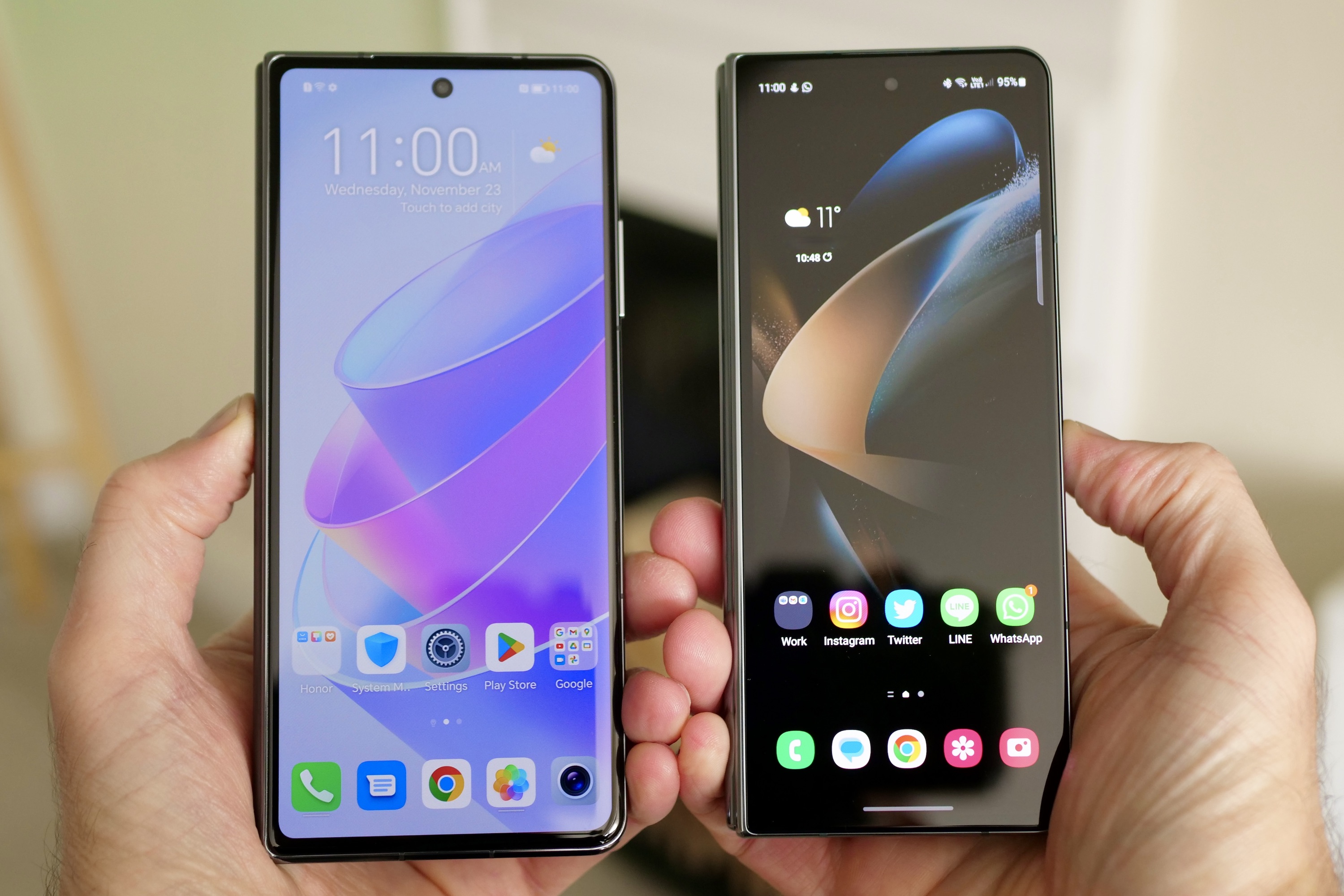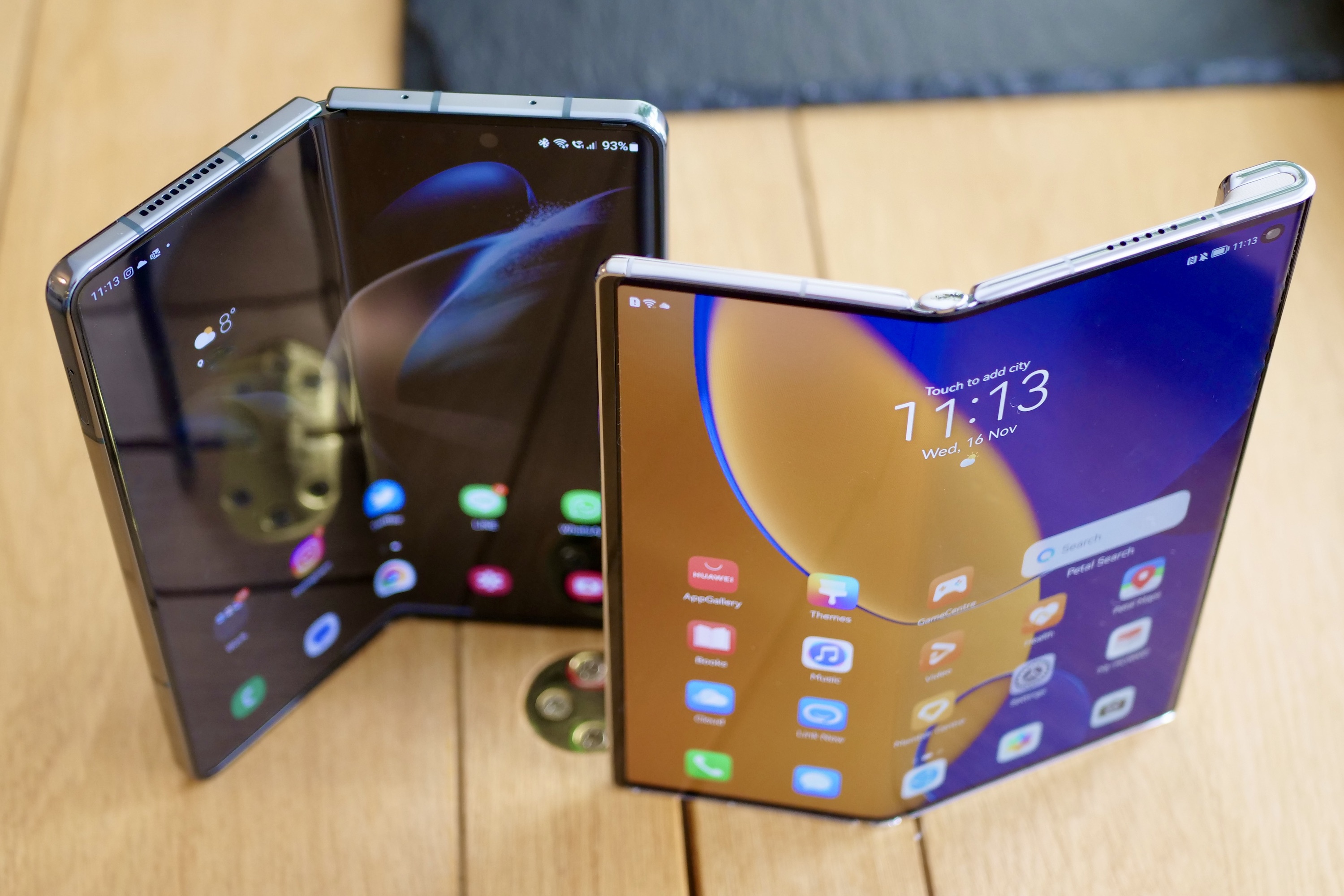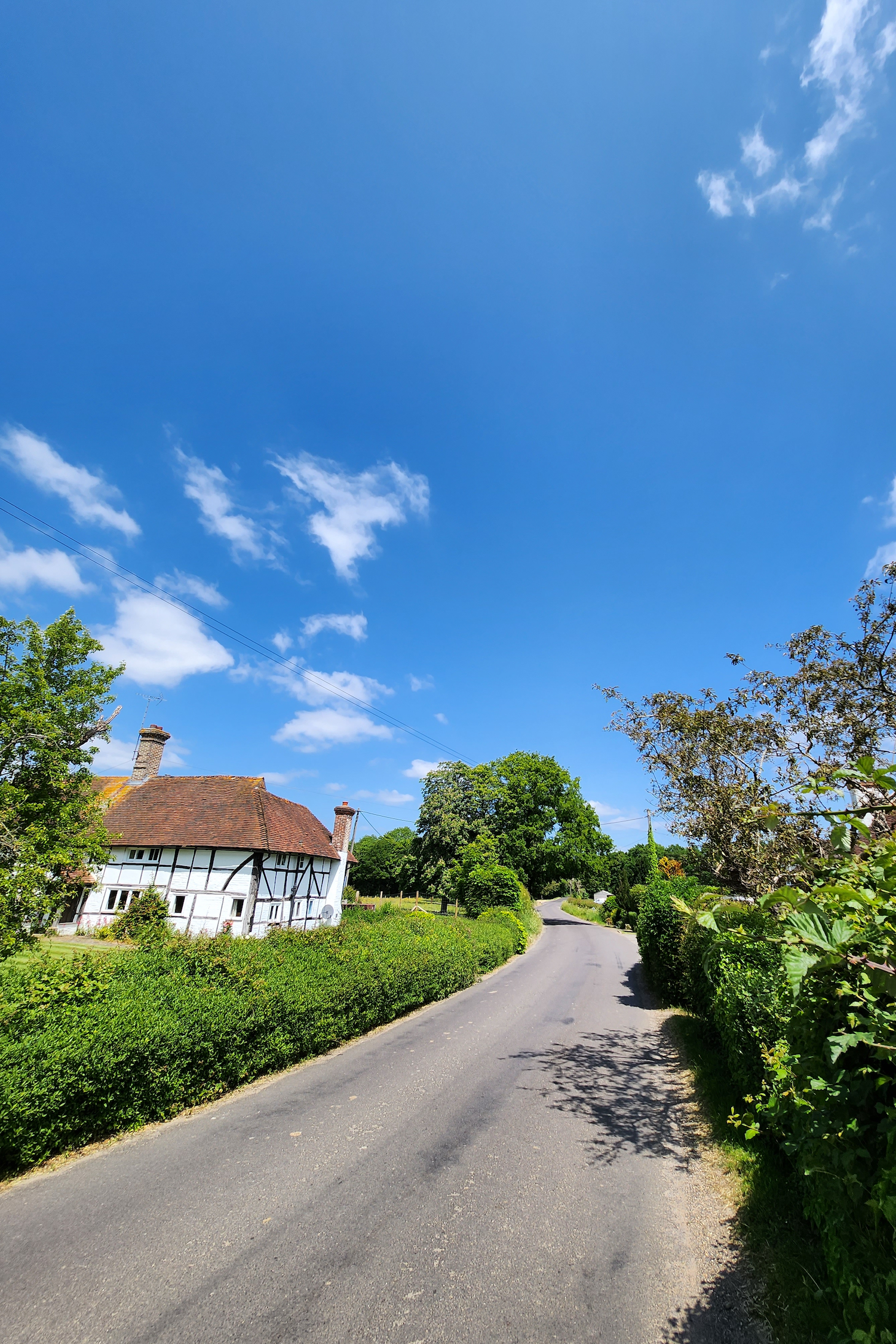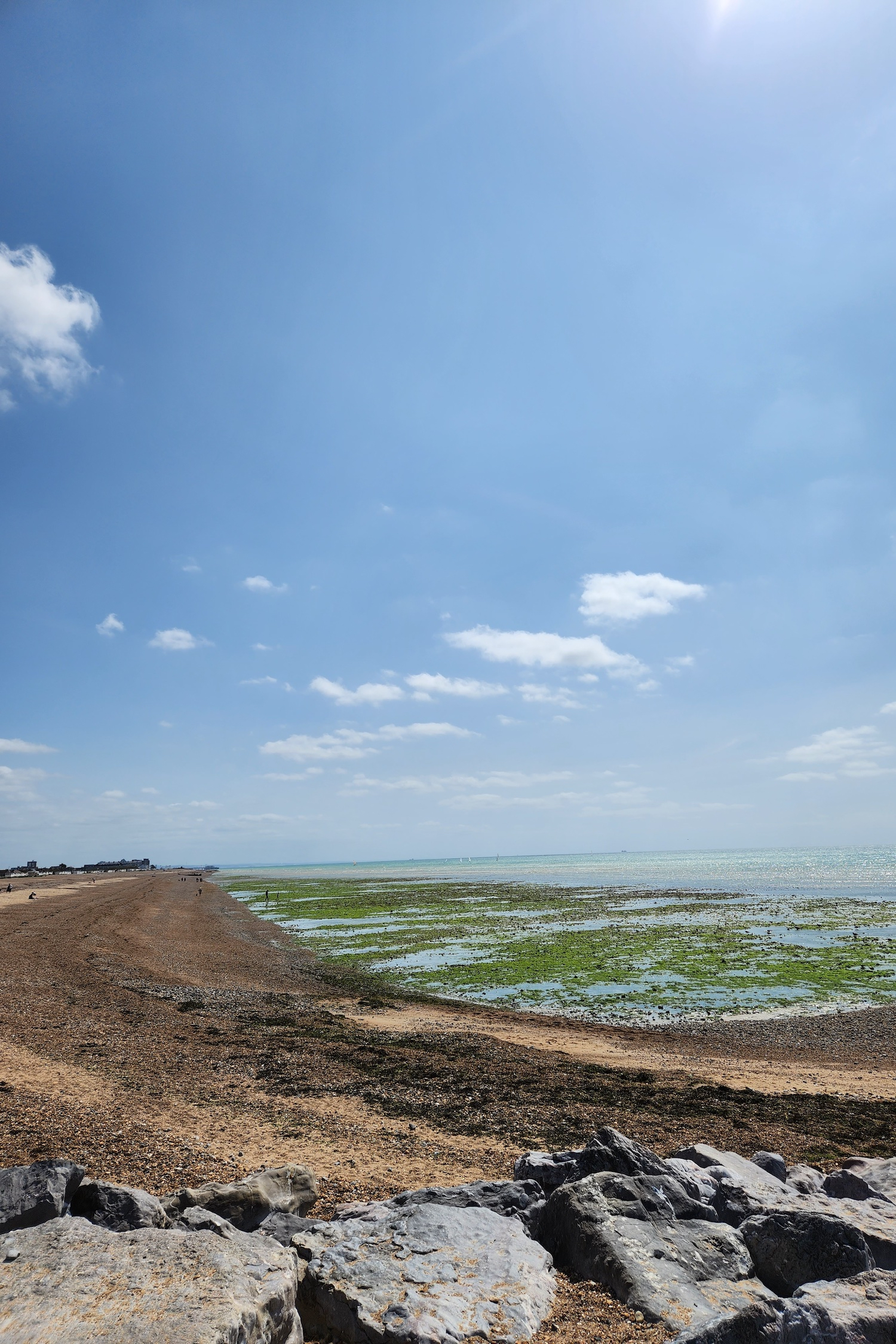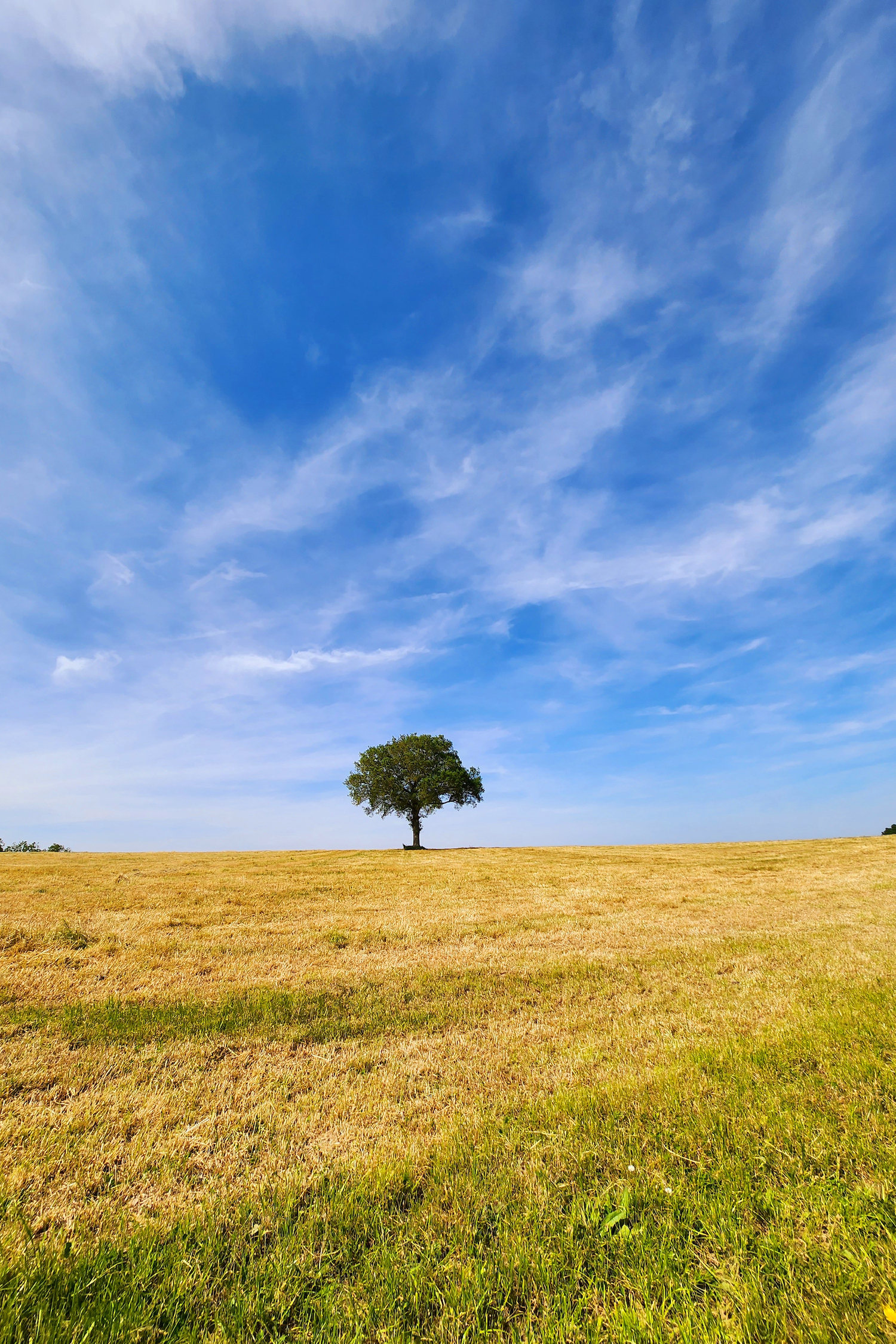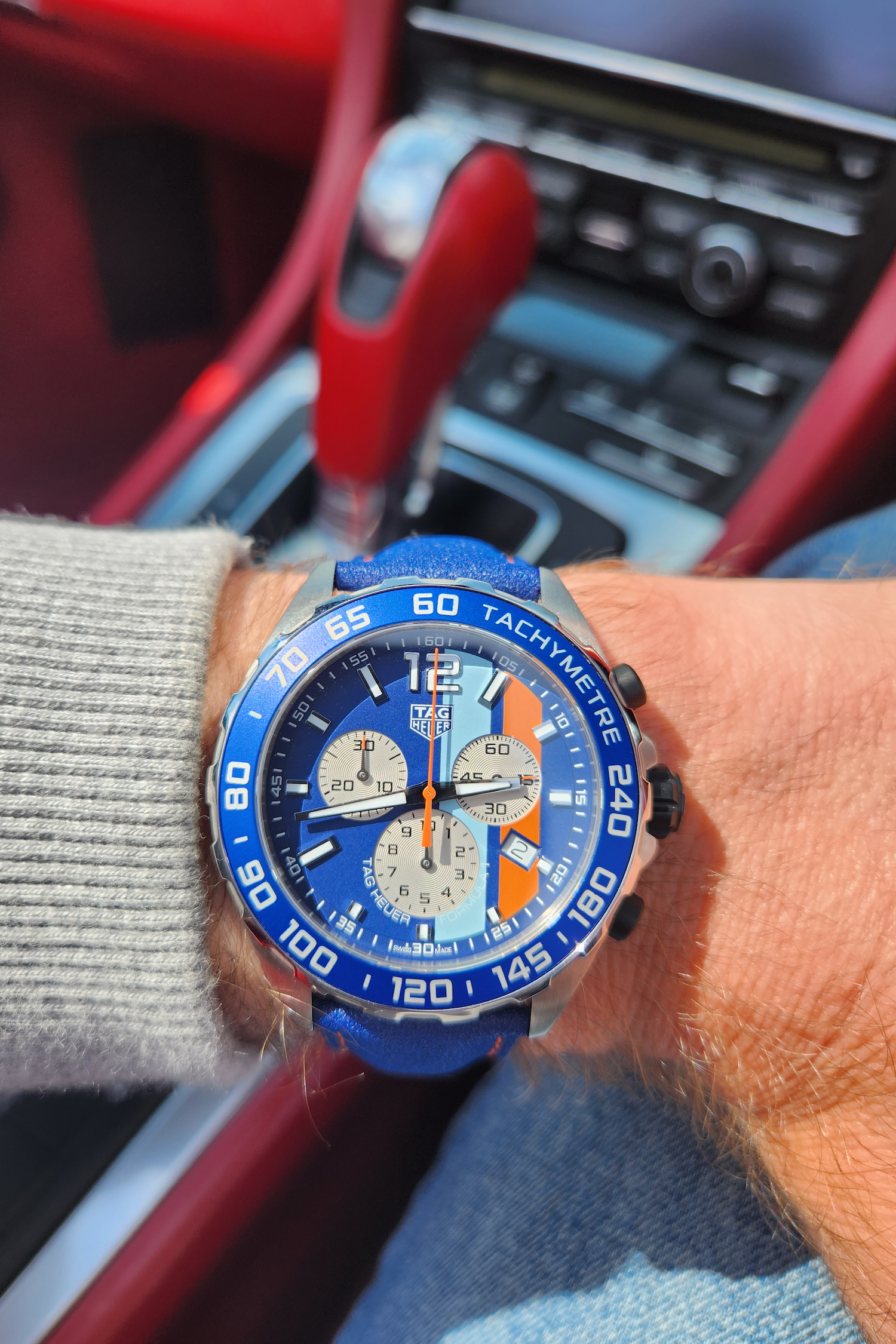“The Galaxy Z Fold 4 is less compromised, more powerful, and more durable than its predecessors. The battery struggles to keep up with its ability, but otherwise, it's one of the very best smartphones you can buy today.”
- Usable cover screen
- Excellent multitasking features
- Inner screen is great for games and video
- Reliable and fun camera
- Water resistant and durable materials
- Heavy use kills the battery
- Slow charging
Lazy old Samsung barely changed the Galaxy Z Fold 4 over the Galaxy Z Fold 3, right? It’s very easy to think this after a quick glance at the design or a side-by-side check of the stats, but don’t judge this book by its cover (screen), as Samsung’s many small alterations add up to something far greater.
Yes, greater. The Z Fold 4 is really the first time the biggest Samsung folding smartphone can be recommended to most people, and if you invest in one, it has the power and ability to remain in use for years. Here’s why it’s such a big step forward.
Samsung Galaxy Z Fold 4: design

Not quite as tall and not quite as slim. That’s the basic main takeaway regarding the Galaxy Z Fold 4 compared to the Galaxy Z Fold 3, but to leave it at that is a disservice to the differences the millimeter-tight changes make. When closed, gripping the Z Fold 4 isn’t quite like holding a non-folding phone, but it’s not far off. When you compare on-screen keyboards, the Z Fold 4’s letters are a few extra pixels wide, yet I’ve found typing to be faster and more accurate on the Z Fold 4. It’s also great that Google’s Gboard keyboard has joined Samsung’s own with a split view.
I didn’t have a problem using the Z Fold 3 closed, but there’s no doubt it’s a better, more conventional experience on the Z Fold 4. The aspect ratio change doesn’t squash everything into that odd vertical-letterbox look anywhere nearly as much, and that means reading text, looking at Instagram, and just doing regular phone things isn’t as compromised as before. The 3mm or so that has been added to the Cover Screen may not sound like much at all, but it has genuinely made the phone more usable when closed.
Samsung explained that the changes to the size of the phone were made possible in part by a new hinge design. My Z Fold 3 is a year old, and the hinge has settled into a very pleasant, dampened motion after starting off pretty stiff. The Z Fold 4 has also started out life with less “give” than I’d like, but it’s likely to loosen up just like the Z Fold 3. It’s soundless, with no audible grinding or anything awful like that, and there’s a nice thunk when the phone snaps closed. If Samsung hadn’t explained what’s different about the hinge, I don’t think I’d have known it had changed based on feel alone, and that’s a good thing.
However, you’re still dealing with a very thick and heavy phone. It’s 263 grams and 15.8mm thick when closed, so it weighs your pocket down, and it’s always obvious when it’s in a bag. But again, it’s not as hefty as the Z Fold 3. In all aspects of its physical shape and size, the Z Fold 4 is a considerable step forward over its predecessor. While I think the changes make the Z Fold 4 more accessible, they may not be extensive enough to convert detractors or those who disliked the Z Fold 3. It’s different, but not drastically so.
I’ll admit it, I’m a folding phone convert. I’ll live with the increased thickness and weight because opening the phone up and using the large screen to browse the web, watch videos, read books, edit photos, and scroll through Twitter is a fantastic experience because the same device then folds down to fit in my pocket. It’s hugely freeing, and I find it more convenient than carrying other non-folding, but still massive phones like the Galaxy S23 Ultra or iPhone 14 Pro Max around.
I love the little things about it, too, like the way you can fold it so it becomes its own stand for watching videos and how wonderfully sharp the screen is for reading magazines and ebooks. It’s understandable if you’re not convinced, but if you haven’t tried the Galaxy Z Fold 4 for yourself but are becoming more intrigued, go out and give it a try. This may just be the one that convinces you that large-screen foldables are ready for the mainstream.
Galaxy Z Fold 4: screens
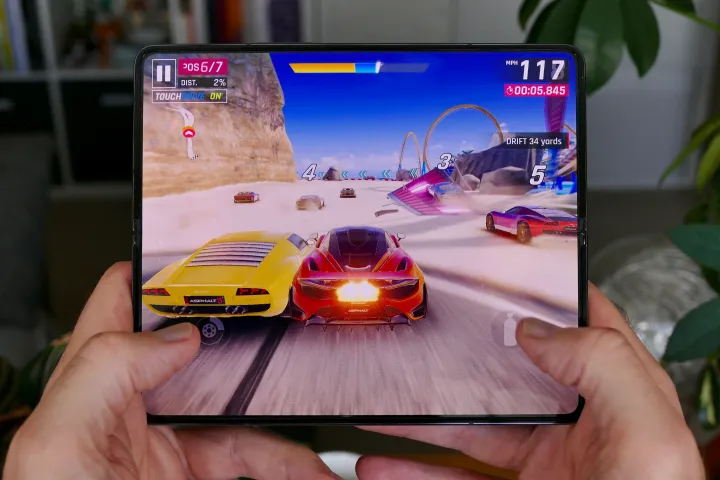
On the outside is a 6.2-inch Dynamic AMOLED screen with a 2316 x 904 resolution, a 120Hz refresh rate, and a 23.1:9 aspect ratio. Open the phone, and you get a 7.6-inch Dynamic AMOLED, also with a 120Hz refresh rate, plus a 2176 x 1812 resolution. The refresh rate for the open screen varies between 1Hz and 120Hz, while the cover screen varies between 48Hz and 120Hz.
The smaller bezels around the cover screen and alterations to the shape of the phone have made it far more usable and are integral to the improved design and usability of the phone. The inside screen is where you go to watch videos, play games, read books, view and edit photos, and multitask. The good news is the new shape has made it more usable here, too. I’ve had no problem with brightness when using the phone outside, although the inner screen is quite reflective.
What about the crease? It’s still there, but the rippling around it has been reduced, so it’s not quite so visibly obvious anymore. It has remained consistent months into use and hasn’t become more prominent. This applies to when the screen is on and off. I’ve noticed “not noticing” when using the open screen on the Z Fold 4 many times already, and the concave dip when running your finger across it is a tiny bit less dramatic too.
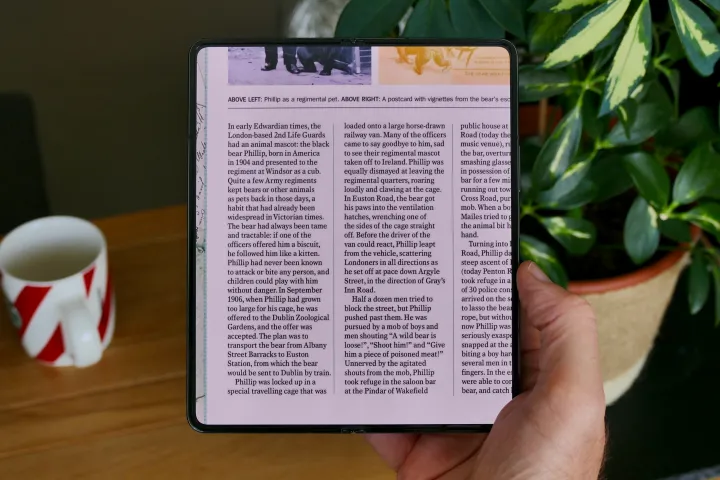
Asphalt 9: Legends looks fantastic, full of vibrant color, and with no blur or slow-down at all. Video also looks sharp and packed with detail. Just remember to check the brightness, because the phone has a habit of setting it a little too low to really enjoy the picture. App support for the large screen is good, but there are things to get used to. For example, Instagram still doesn’t use the whole screen, while YouTube doesn’t adopt the excellent tablet view from the iPad and is just a big-print version of the mobile app — making choosing videos a laborious task.
All Samsung apps and the core Google apps are really slick, though, and there’s something supremely satisfying about starting out in an app on the cover screen and seamlessly swapping to the other screen when you open the Z Fold 4. For it to operate the other way around, you have to go into Settings and manually force apps to continue on the Cover Screen from the inner screen. By default, they are all disabled, and closing the phone is very final, as the screen shuts off.
And, yes, the Galaxy Z Fold 4’s unique design makes it a perfect Kindle replacement.
Galaxy Z Fold 4: camera

The Galaxy Z Fold 4 has a 50-megapixel main camera, a 12MP 123-degree wide-angle camera, and a 10MP telephoto camera with 3x optical zoom and 30x maximum digital zoom. Video records at up to 8K at 24 frames per second (fps, with the option of 4K at 30 or 60 fps. Plus, there’s Samsung’s excellent Super Steady video stabilization. There’s a Pro mode for stills and video, a night mode, Single Take, and portrait mode on the main and selfie camera.
I find the combination of a strong main camera, a good wide-angle, and 3x optical zoom to be just right, and the Z Fold 4 takes excellent photos with all three. It’s vibrant and colorful without being overly saturated, the wide-angle remains mostly consistent with a slightly stronger HDR effect, and the 3x telephoto pictures contain a lot of detail and no obvious digital enhancements. Portrait mode works really well, with fantastic edge recognition, while night mode is also good but not all that different in performance from the Z Fold 3.
The main camera has a more natural look than the Z Fold 3’s, with less saturation and far better balance. The wide-angle camera takes more detailed, better-exposed, and more attractive photos. I’ve found I want to edit the photos the Z Fold 4 takes less than the ones taken on the Z Fold 3, and have been confident in its abilities when out taking pictures. It can’t match the S23 Ultra’s 10x optical zoom, but it’s an otherwise strong competitor as a fantastic all-rounder for both casual photographers and those who want a little more ability.
- 1. Wide-angle
- 2. Main
- 3. 3x zoom
What’s not so good? The main camera isn’t great at taking close-ups and fails to focus properly if the subject is too near the camera. And while the telephoto camera can zoom to 30x, it’s difficult to recommend. Unless you want to take pixelated, obviously digitally enhanced photos of poor quality, you won’t want to bother.
The Under Display Camera (UDC) has 4MP and is really no better than the one fitted to the Z Fold 3. It returns a soft image during video calls and is far less sharp than the 10MP selfie camera on the cover screen. Samsung claims to have made the UDC camera less noticeable too, but to my eyes, it’s essentially the same. You can spot it when you look for it, but it’s never bothersome.
While you’ll probably use the camera from the cover screen most of the time, there’s an advantage to using the camera with the Z Fold 4 open. It’s called Capture View, and it shows the viewfinder and controls on the right and a vertical gallery view on the left. It’s really helpful to immediately see the photos you’ve taken in busy, action-packed situations, or even to check the quality of your selfie. The cover screen can be called into action when using the phone open like this, allowing your subject to see themselves when you’re taking a photo, or for you to use the rear camera for selfies.
The Z Fold 4’s camera is very good and a definite improvement over the one on the Z Fold 3. I’ve been able to rely on it, and think the natural-but-color-filled photos will satisfy those who don’t like extreme saturation levels, while still looking good enough to share online without drastic editing. The software is fast and packed with features, and the app makes good use of the multiple screens and layouts. You’ll have a lot of fun with the Z Fold 4’s camera.
Galaxy Z Fold 4: software and performance

The Galaxy Z Fold 4 started out with Google’s Android 12L software, which has been made with larger screens in mind, and Samsung’s own OneUI 4.1.1 interface. Android 12L isn’t drastically different from regular Android 12, and Samsung hasn’t integrated the two-column Quick Settings layout, which is the most obvious visual change. It has since been updated to Android 13 (which includes all Android 12L enhancements) and OneUI 5.1. Powering the phone is a Qualcomm Snapdragon 8+ Gen 1 processor with 12GB of RAM and your choice of 256GB, 512GB, or 1TB of internal storage space.
One of the main new features is the Taskbar, which, as its name suggests, is like the Windows Taskbar or MacOS’s Dock, as it adds app icons to the bottom of the screen when the phone is open. It’s designed to quickly switch between apps, and it does indeed perform this task very well. The problem is, so does the helicopter view when you swipe up on the screen, and Samsung’s ever-present slide-in smart bar.
While it’s well implemented, it feels superfluous for switching apps at first, but do give it a try because it’s faster than any of the other systems, with apps switching practically instantly. It’s also helpful when multitasking, as the icons show notification numbers. The layout mirrors the main Android dock, so it’s easy to put important apps there and always be alerted if there are notifications waiting.
Multitasking is a big part of what makes the Z Fold 4 so compelling.
Using multiple apps at the same time on the inner screen is one of the standout advantages of the Z Fold 4. It’s very easy to get started: just tap and hold an app from the Taskbar or the Smart bar, then slide it onto the screen, where it automatically reorients around the already running apps. Three apps can run alongside each other, plus some apps can float over the top for a fourth app. And they all remain perfectly usable (just a bit small) when you do it. It’s really well implemented and genuinely makes the unfolded Z Fold 4 a phone that gets a lot of things done quickly and without fuss.
It’s a credit to both the software and the Snapdragon 8+ Gen 1 that the phone handles four-app multitasking with ease. With a multiperson Teams call running and Twitter on the other side of the screen, all while connected to a pair of Galaxy Buds 2 Pro, the phone didn’t get hot at all. It did put some strain on the battery, though, which we will come back to shortly. Multitasking is a big part of what makes the Z Fold 4 so compelling, as the experience is refined and simple, and the inside screen has the size and quality to make using more than one app at a time actually worthwhile.
I’ve been consistently impressed with the Snapdragon 8+ Gen 1, ever since early phones like the Asus Zenfone 9, the ROG Phone 6 Pro, and the iQoo 9T. It’s clearly more efficient than the 8 Gen 1 and handles the strain of top-tier gaming and higher ambient temperatures better too. It doesn’t seem to get as hot in general, and that helps it cope with the demands put on it by the phone’s sheer ability. It has been superseded at the top of the range by the Snapdragon 8 Gen 2 since the Z Fold 4’s release, but don’t let that put you off. Both are immensely capable. I have had no problem with the Z Fold 4’s 5G connectivity or Bluetooth, and call quality has been very good.
Galaxy Z Fold 4: battery and charging
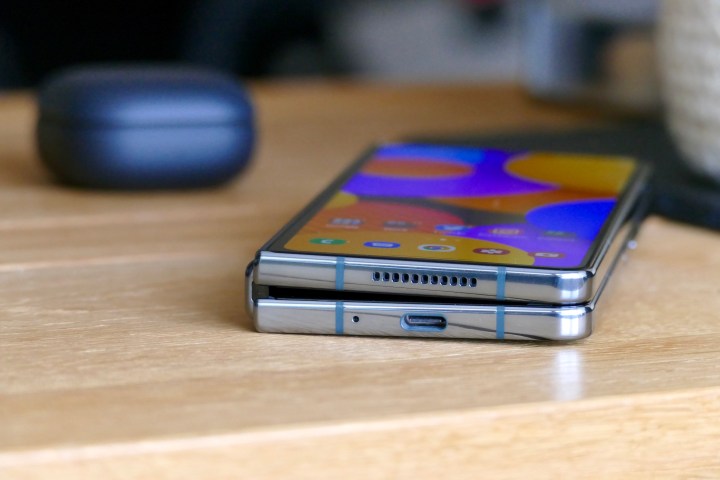
There’s a dual-cell 4,400 mAh battery inside the Galaxy Z Fold 4, and at the moment, it is the weakest part of this otherwise superb package. Early on, hard use saw the battery run out of power before the end of a full day, after a combination of apps, video calls, GPS, and camera use, with a total of just under four hours of screen time. A one-hour video call with some multitasking during it took the battery down by 20%, while a morning of 5G connectivity, photos, and GPS took about half the battery life with it.
Since then it has settled down, and changes to the software have made it more efficient, but don’t expect much more than a full day if you push it hard. Without playing games and with around three hours of screen time, it can stretch out to the end of a second working day though. But when the phone is this capable and so obviously built for media and multitasking, it probably won’t happen very often. Also remember that if you’ve just bought the phone and are frustrated by the battery life, in my experience it will get better, as Samsung phones can take about two weeks to settle down as it learns your use patterns.
You don’t get a charger in the box with the phone (but you do get a USB Type-C cable), and the Z Fold 4 supports 25-watt charging. A compatible charger took 88 minutes to recharge from 1% to full. The phone also supports wireless charging at a lower wattage, and the Wireless PowerShare feature will charge a Qi-compatible device placed on the back of the Z Fold 4 too.
The slow charging speed is a disappointment. While the U.S. may be slightly behind the curve with truly rapid charging, with only OnePlus pushing the boundaries, the rest of the world is used to more phones charging to full in 30 minutes or less, which is a feature that’s available on devices that cost a third of the Galaxy Z Fold 4’s price. The shorter-than-ideal battery life will make the slow charging more of an issue for some.
Comparing the Z Fold 4 to other foldables in 2023

Since the Galaxy Z Fold 4 was released, several competitors have emerged, although not many are available in the U.S. directly. How has the Z Fold 4 fared against them, and what about its future? Soon after the Z Fold 4’s release, I tested the camera against the Galaxy Z Fold 3 to better understand the improvements, and the new model went on to win five out of the seven categories. Changes to the Image Signal Processor (ISP) and the chipset helped make the most of the new cameras.
It was interesting to use the Oppo Find N2, which has a shorter, wider design than the Z Fold 4, offering a different perspective on big-screen foldables. It’s this design that Google has adopted for the Pixel Fold — arguably the Z Fold 4’s most significant challenger yet — as it’ll actually be available in the U.S. We’d recommend waiting for reviews before leaping on a Pixel Fold, though.
In the U.K., you can buy the Honor Magic Vs, which is a little cheaper than the Z Fold 4, but after using them back-to-back, it’s easy to advise spending more to get the Z Fold 4.
The Huawei Mate Xs 2 is also another consideration, and it folds in the opposite way to the Z Fold 4, opening outwards so its cover screen also becomes the main screen. The phone’s hardware is excellent, but the phone’s software requires some patience and doesn’t have the Google Play Store. Elsewhere, I was impressed by the significantly cheaper Tecno Phantom V Fold and how much promise it showed, while others have even preferred it to the Z Fold 4 in some ways. However, for me, none have come close to matching the Galaxy Z Fold 4 for consistency or ease of use, and can’t match all the important durability features either.
Going back to the Galaxy Z Fold 4 in June 2023 was a wonderful experience, and it still has all the appeal it did when it launched in 2022. Samsung only needs to work on refining the winning formula for the Galaxy Z Fold 5, and it’ll still likely be streets ahead of the others. In the meantime, the Galaxy Z Fold 4 remains a great purchase in 2023, but we’d say right now it’s wise to see how the Pixel Fold does when it’s reviewed — and to see what the Galaxy Z Fold 5 brings in updates — before buying one.
How is the Z Fold 4’s software in 2023?
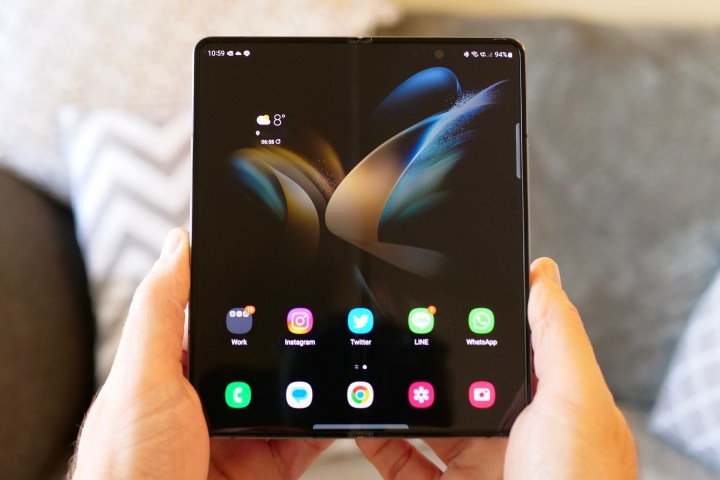
I’ve been using the Galaxy Z Fold 4 since its release, and the good news is it continues to be a reliable, capable, and exciting everyday phone. It received an update to the One UI 5 software early on and is currently running the latest OneUI 5.1 version, complete with the May 2023 security patch. The Z Fold 4 is not only fully up to date but feels fresh too, and the strong software support from Samsung (it will receive four years of major updates from the time of its launch) is a reason to buy — and something that far surpasses the competition.
At the end of 2022, the Z Fold 4 received an update so it can use Samsung’s Expert RAW app, meaning you can take photos in RAW format and then edit them in the Adobe Lightroom app. This is one of the major attractions of the Galaxy S23 Ultra, and you don’t have to be an expert to enjoy the feature, so don’t be put off by the name. Additionally, a further update has added an Astrophotography mode to the Expert RAW app on the Z Fold 4. It’s great to see new, enjoyable features being added on a regular basis.
The Z Fold 4’s camera is a lot of fun and is still versatile enough to hold its own in 2023. Sure, the photos are full of color in that typical Samsung way, but it’s impossible not to smile at the way they pop off the screen. Some more recent camera samples can be seen in the gallery above.
Over the months I’ve been using the Z Fold 4, I’ve been using features specific to it in fun ways, while others have really dug deep to get the most from the unfolded big screen. The Galaxy Z Fold 4 is every bit a modern, capable flagship smartphone in 2023.
Galaxy Z Fold 4: price and availability
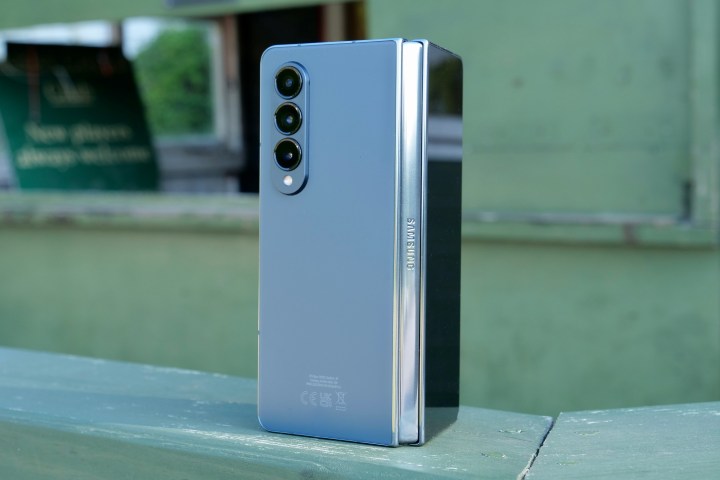
The Galaxy Z Fold 4 starts at $1,799 for the 256GB version, then increases to $1,920 for the 512GB model, before reaching $2,160 for the top 1TB version. In the U.K., the 256GB phone costs 1,649 British pounds, while you’ll pay 1,769 pounds for the 512GB model and 2,019 pounds for the top 1TB model. There are three main colors: Phantom Black, beige, and Greygreen. Samsung sells an through its own store.
Although expensive, Samsung has generous trade-in offers. There are often strong discounts at carriers and retailers out there, so it’s absolutely worth doing your research before buying, as it’s possible to reduce the initially high price quite considerably.
Samsung Galaxy Z Fold 4: verdict
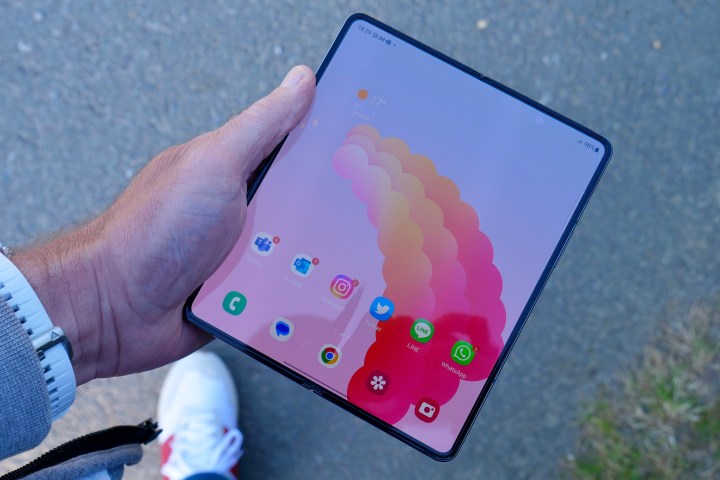
Small changes make a big difference. On paper, nothing about the Galaxy Z Fold 4 screams “huge upgrade” over the Z Fold 3, and it’s easy to assume it’s just an iterative update that doesn’t solve any of the issues people have with big folding smartphones. But that’s not the case. The small changes to the shape, weight, and specifications have made it a far more realistic everyday device for a lot more people, provided you can get past the high price. Even then, there’s actually good value here when you consider the longevity offered by the hardware and software.
The Galaxy Z Fold 4 looks and feels futuristic and contains cutting-edge tech, but that cannot be said about the battery and charging. It charges slowly compared to many other current phones, and there’s a very real likelihood of the battery running out before the end of the day if you use the phone as it demands to be used. Both these aspects will make it difficult for some people to truly exploit its massive ability.
There are fewer compromises here than with its predecessors, the work that has gone into making the phone’s design more compliant and usable is really impressive, and fears over durability have largely been removed. The software is regularly updated and has matured nicely, with most apps and services working cohesively across both screens. And because of the long-term support updates that come from Samsung and Google’s ongoing partnership, the Z Fold 4 will keep feeling fresh for years to come.
Even with the shorter-than-desired battery life, the Galaxy Z Fold 4 is the most complete, does-everything-will-last-for-years mobile device you can buy today.



